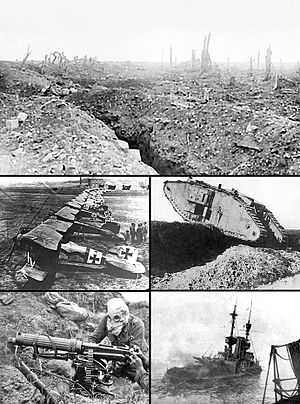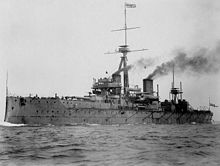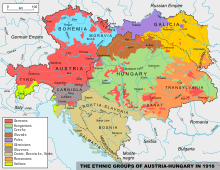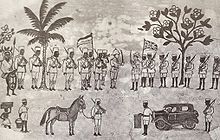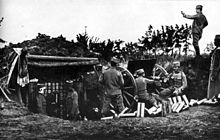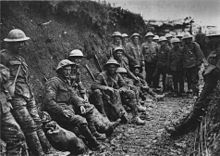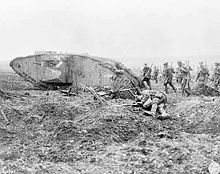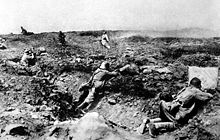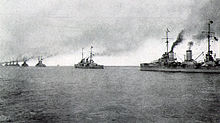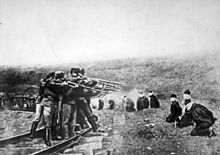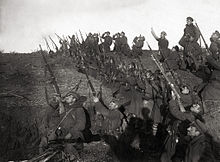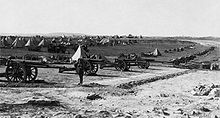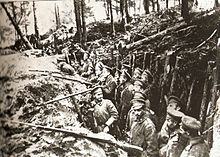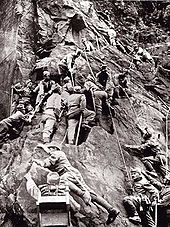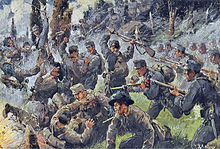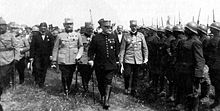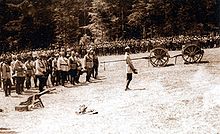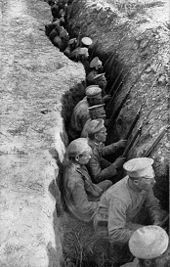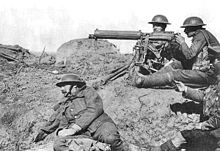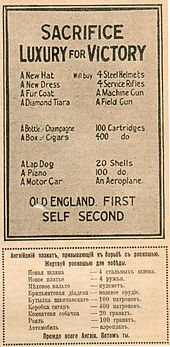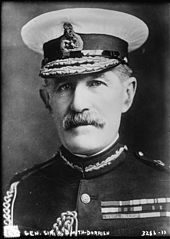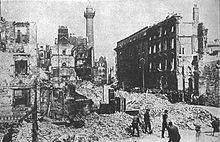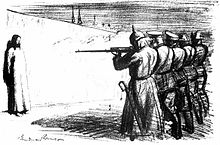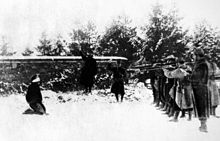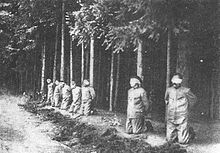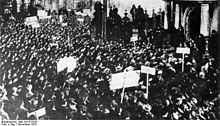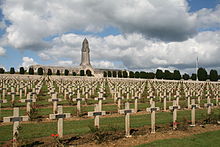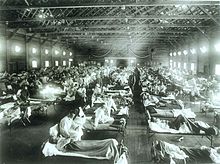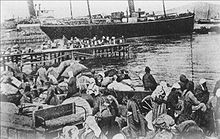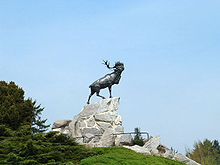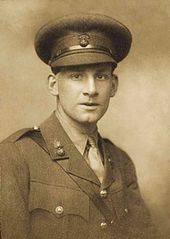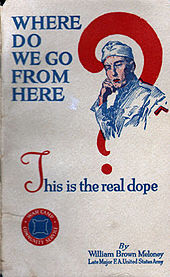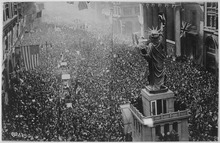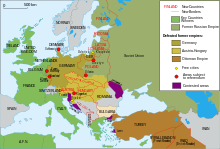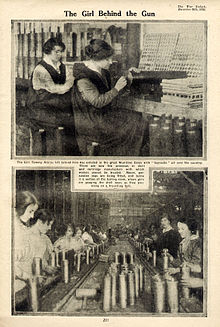
World War I
Did you know...
This Schools selection was originally chosen by SOS Children for schools in the developing world without internet access. It is available as a intranet download. SOS Child sponsorship is cool!
|
||||||||||||||||||||||||||||
|
||||||||||||||||||||||||||||
World War I (WWI) was a global war centred in Europe that began on 28 July 1914 and lasted until 11 November 1918. It was predominantly called the World War or the Great War from its occurrence until the start of World War II in 1939, and the First World War or World War I thereafter. It involved all the world's great powers, which were assembled in two opposing alliances: the Allies (based on the Triple Entente of the United Kingdom, France and Russia) and the Central Powers (originally the Triple Alliance of Germany, Austria-Hungary and Italy; but, as Austria–Hungary had taken the offensive against the agreement, Italy did not enter into the war). These alliances were both reorganised and expanded as more nations entered the war: Italy, Japan and the United States joined the Allies, and the Ottoman Empire and Bulgaria the Central Powers. Ultimately, more than 70 million military personnel, including 60 million Europeans, were mobilised in one of the largest wars in history. More than 9 million combatants were killed, largely because of technological advancements that led to enormous increases in the lethality of weapons without corresponding improvements in protection or mobility. It was the sixth- deadliest conflict in world history, subsequently paving the way for various political changes, such as revolutions in many of the nations involved.
One of the long-term causes of the war was the resurgence of imperialism in the foreign policies of the great powers of Europe. More immediately, the assassination of Archduke Franz Ferdinand of Austria, the heir to the throne of Austria-Hungary, on 28 June 1914 by Yugoslav nationalist Gavrilo Princip in Sarajevo was triggered a diplomatic crisis when Austria-Hungary subsequently delivered an ultimatum to the Kingdom of Serbia. Several alliances formed over the previous decades were invoked, so, within weeks, the major powers were at war; via their colonies, the conflict soon spread around the world.
On 28 July, the Austro-Hungarians fired the first shots of the war as preparation for the invasion of Serbia. While the Russians mobilised, the Germans invaded neutral Belgium and Luxembourg on the way to France, providing a case for Britain's declaration of war against Germany. After the German march on Paris was brought to a halt—the so-called Miracle of the Marne—the Western Front settled into a static battle of attrition with a trench line that changed little until 1917. On the Eastern Front, the Russian army was successful against the Austro-Hungarians, but was stopped in its invasion of East Prussia by the Germans. In November the Ottoman Empire joined the war, opening up fronts in the Caucasus, Mesopotamia and the Sinai. Italy and Bulgaria went to war in 1915 and Romania in 1916. In Russia, the tsar's government collapsed in March 1917 and a subsequent revolution in November brought the Russians to terms with the Central Powers. After a 1918 German offensive along the western front, the Allies drove back the Germans in a series of successful offensives and American forces began entering the trenches. Germany, which had its own trouble with revolutionaries, agreed to an armistice on 11 November 1918. The war ended in victory for the Allies.
Events on the home fronts were as tumultuous as on the battle fronts, as the participants tried to mobilize their manpower and economic resources to fight a total war. By the end of the war, four major imperial powers—the German, Russian, Austro-Hungarian and Ottoman empires—ceased to exist. The successor states of the former two lost a great amount of territory, while the latter two were dismantled entirely. The map of central Europe was redrawn into several smaller states. The League of Nations was formed in the hope of preventing another such conflict. The European nationalism spawned by the war and the breakup of empires, the repercussions of Germany's defeat and problems with the Treaty of Versailles are agreed to be factors contributing to World War II.
Names
In Canada, Maclean's Magazine in October 1914 said, "Some wars name themselves. This is the Great War." A history of the origins and early months of the war published in New York in late 1914 was titled The World War. During the Interwar period, the war was most often called the World War and the Great War in English-speaking countries.
After the onset of the Second World War in 1939, the terms World War I or the First World War became standard, with British and Canadian historians favouring the First World War, and Americans World War I. Both of these terms had also been used during the Interwar period. The term "First World War" was first used in September 1914 by the German philosopher Ernst Haeckel, who claimed that "there is no doubt that the course and character of the feared 'European War' ... will become the first world war in the full sense of the word." The First World War was also the title of a 1920 history by the officer and journalist Charles à Court Repington.
Background
In the 19th century, the major European powers had gone to great lengths to maintain a balance of power throughout Europe, resulting in the existence of a complex network of political and military alliances throughout the continent by 1900. These had started in 1815, with the Holy Alliance between Prussia, Russia, and Austria. Then, in October 1873, German Chancellor Bismarck negotiated the League of the Three Emperors (German: Dreikaiserbund) between the monarchs of Austria–Hungary, Russia and Germany. This agreement failed because Austria–Hungary and Russia could not agree over Balkan policy, leaving Germany and Austria–Hungary in an alliance formed in 1879, called the Dual Alliance. This was seen as a method of countering Russian influence in the Balkans as the Ottoman Empire continued to weaken. In 1882, this alliance was expanded to include Italy in what became the Triple Alliance.
After 1870, European conflict was averted largely through a carefully planned network of treaties between the German Empire and the remainder of Europe orchestrated by Bismarck. He especially worked to hold Russia at Germany's side to avoid a two-front war with France and Russia. When Wilhelm II ascended to the throne as German Emperor (Kaiser), Bismarck was compelled to retire and his system of alliances was gradually de-emphasised. For example, the Kaiser refused to renew the Reinsurance Treaty with Russia in 1890. Two years later, the Franco-Russian Alliance was signed to counteract the force of the Triple Alliance. In 1904, the United Kingdom signed a series of agreements with France, the Entente Cordiale, and in 1907, the United Kingdom and Russia signed the Anglo-Russian Convention. While these agreements did not formally ally the United Kingdom with France or Russia, they made British entry into any future conflict involving France or Russia probable, and the system of interlocking bilateral agreements became known as the Triple Entente.
German industrial and economic power had grown greatly after unification and the foundation of the Empire in 1871. From the mid-1890s on, the government of Wilhelm II used this base to devote significant economic resources for building up the Kaiserliche Marine ( Imperial German Navy), established by Admiral Alfred von Tirpitz, in rivalry with the British Royal Navy for world naval supremacy. As a result, each nation strove to out-build the other in terms of capital ships. With the launch of HMS Dreadnought in 1906, the British Empire expanded on its significant advantage over its German rival. The arms race between Britain and Germany eventually extended to the rest of Europe, with all the major powers devoting their industrial base to producing the equipment and weapons necessary for a pan-European conflict. Between 1908 and 1913, the military spending of the European powers increased by 50 percent.
Austria-Hungary precipitated the Bosnian crisis of 1908–1909 by officially annexing the former Ottoman territory of Bosnia and Herzegovina, which it had occupied since 1878. This angered the Kingdom of Serbia and its patron, the Pan-Slavic and Orthodox Russian Empire. Russian political manoeuvring in the region destabilised peace accords, which were already fracturing in what was known as "the powder keg of Europe".
In 1912 and 1913, the First Balkan War was fought between the Balkan League and the fracturing Ottoman Empire. The resulting Treaty of London further shrank the Ottoman Empire, creating an independent Albanian State while enlarging the territorial holdings of Bulgaria, Serbia, Montenegro, and Greece. When Bulgaria attacked both Serbia and Greece on 16 June 1913, it lost most of Macedonia to Serbia and Greece and Southern Dobruja to Romania in the 33-day Second Balkan War, further destabilising the region.
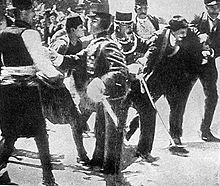
On 28 June 1914, Gavrilo Princip, a Bosnian Serb student and member of Young Bosnia, assassinated the heir to the Austro-Hungarian throne, Archduke Franz Ferdinand of Austria in Sarajevo, Bosnia. This began a month of diplomatic manoeuvring between Austria-Hungary, Germany, Russia, France, and Britain called the July Crisis. Wanting to finally end Serbian interference in Bosnia – the Black Hand had provided Princip and his group with their bombs and pistols, trained them, and helped them across the border, and the Austrians were correct to believe that Serbian officers and officials were involved - Austria-Hungary delivered the July Ultimatum to Serbia, a series of ten demands intentionally made unacceptable, intending to provoke a war with Serbia. When Serbia agreed to only eight of the ten demands, Austria-Hungary declared war on 28 July 1914. Strachan argues, "Whether an equivocal and early response by Serbia would have made any difference to Austria-Hungary's behaviour must be doubtful. Franz Ferdinand was not the sort of personality who commanded popularity, and his demise did not cast the empire into deepest mourning".
The Russian Empire, unwilling to allow Austria–Hungary to eliminate its influence in the Balkans, and in support of its longtime Serb protégés, ordered a partial mobilisation one day later. The German Empire mobilized on 30 July 1914, ready to apply the " Schlieffen Plan", which planned a quick, massive invasion of France to eliminate the French army, then to turn east against Russia. The French cabinet resisted military pressure to commence immediate mobilisation, and ordered its troops to withdraw 10 km from the border to avoid any incident. France only mobilized on the evening of 2 August, when Germany invaded Belgium and attacked French troops. Germany declared war on Russia on the same day. The United Kingdom declared war on Germany on 4 August 1914, following an "unsatisfactory reply" to the British ultimatum that Belgium must be kept neutral.
Theatres of conflict
Opening hostilities
Confusion among the Central Powers
The strategy of the Central Powers suffered from miscommunication. Germany had promised to support Austria-Hungary's invasion of Serbia, but interpretations of what this meant differed. Previously tested deployment plans had been replaced early in 1914, but the replacements had never been tested in exercises. Austro-Hungarian leaders believed Germany would cover its northern flank against Russia. Germany, however, envisioned Austria-Hungary directing most of its troops against Russia, while Germany dealt with France. This confusion forced the Austro-Hungarian Army to divide its forces between the Russian and Serbian fronts.
On 9 September 1914, the Septemberprogramm, a possible plan that detailed Germany's specific war aims and the conditions that Germany sought to force on the Allied Powers, was outlined by German Chancellor Theobald von Bethmann-Hollweg. It was never officially adopted.
African campaigns
Some of the first clashes of the war involved British, French, and German colonial forces in Africa. On 7 August, French and British troops invaded the German protectorate of Togoland. On 10 August, German forces in South-West Africa attacked South Africa; sporadic and fierce fighting continued for the rest of the war. The German colonial forces in German East Africa, led by Colonel Paul von Lettow-Vorbeck, fought a guerrilla warfare campaign during World War I and only surrendered two weeks after the armistice took effect in Europe.
Serbian campaign
Austria invaded and fought the Serbian army at the Battle of Cer and Battle of Kolubara beginning on 12 August. Over the next two weeks, Austrian attacks were thrown back with heavy losses, which marked the first major Allied victories of the war and dashed Austro-Hungarian hopes of a swift victory. As a result, Austria had to keep sizable forces on the Serbian front, weakening its efforts against Russia. Serbia’s defeat of the Austro-Hungarian invasion of 1914 counts among the major upset victories of the last century.
German forces in Belgium and France
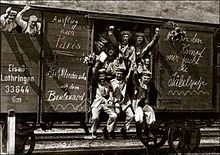
Ausflug nach Paris ("Trip to Paris");
Auf Wiedersehn auf dem Boulevard ("See you later on the Boulevard");
[obscured by flowers] the fight (The obscured part most likely reads Auf in [den Kampf] which means "Into battle"), mir juckt die Säbelspitze "my sabre tip is itching".
Early in the war all sides expected the conflict to be a short one.
At the outbreak of World War I, the German army (consisting in the West of seven field armies) carried out a modified version of the Schlieffen Plan. This marched German armies through neutral Belgium and into France, before turning southwards to encircle the French army on the German border. Since France had declared that it would "keep full freedom of acting in case of a war between Germany and Russia", Germany had to expect the possibility of an attack by France on one front and by Russia on the other. To meet such a scenario, the Schlieffen Plan stated that Germany must try to defeat France quickly (as had happened in the Franco-Prussian War of 1870–71). It further suggested that to repeat a fast victory in the west, Germany should not attack through the difficult terrain of Alsace-Lorraine (which had a direct border west of the river Rhine), instead, the idea was to try to quickly cut Paris off from the English Channel and British assistance, and take Paris, thus winning the war. Then the armies would be moved over to the east to meet Russia. Russia was believed to need a long period of mobilization before they could become a real threat to the Central Powers.
The only existing German plan for a two-front war had German armies marching through Belgium. Germany wanted free escort through Belgium (and originally Holland as well, which plan Kaiser Wilhelm II rejected) to invade France. Neutral Belgium rejected this idea, so the Germans decided to invade through Belgium instead. France also wanted to move their troops into Belgium, but Belgium originally rejected this "suggestion" as well, in the hope of avoiding any war on Belgian soil. In the end, after the German invasion, Belgium did try to join their army with the French (but a large part of the Belgian army retreated to Antwerp where they were forced to surrender when all hope of help was gone).
The plan called for the right flank of the German advance to bypass the French armies (which were concentrated on the Franco-German border, leaving the Belgian border without significant French forces) and move south to Paris. Initially the Germans were successful, particularly in the Battle of the Frontiers (14–24 August). By 12 September, the French, with assistance from the British forces, halted the German advance east of Paris at the First Battle of the Marne (5–12 September), and pushed the German forces back some 50 km. The last days of this battle signified the end of mobile warfare in the west. The French offensive into Southern Alsace, launched on 20 August with the Battle of Mulhouse, had limited success.
In the east, the Russians invaded with two armies, surprising the German staff who had not expected the Russians to move so early. A field army, the 8th, was rapidly moved from its previous role as reserve for the invasion of France, to East Prussia by rail across the German Empire. This army, led by general Paul von Hindenburg defeated Russia in a series of battles collectively known as the First Battle of Tannenberg (17 August – 2 September). But the failed Russian invasion, causing the fresh German troops to move to the east, allowed the tactical Allied victory at the First Battle of the Marne. The Central Powers were denied a quick victory in France and forced to fight a war on two fronts. The German army had fought its way into a good defensive position inside France and had permanently incapacitated 230,000 more French and British troops than it had lost itself. Despite this, communications problems and questionable command decisions cost Germany the chance of early victory.
Asia and the Pacific
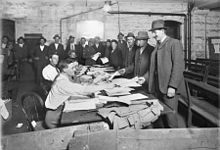
New Zealand occupied German Samoa (later Western Samoa) on 30 August 1914. On 11 September, the Australian Naval and Military Expeditionary Force landed on the island of Neu Pommern (later New Britain), which formed part of German New Guinea. On 28 October, the cruiser SMS Emden sank the Russian cruiser Zhemchug in the Battle of Penang. Japan seized Germany's Micronesian colonies and, after the Siege of Tsingtao, the German coaling port of Qingdao in the Chinese Shandong peninsula. As Vienna refused to withdraw the Austro-Hungarian cruiser „Kaiserin Elisabeth“ from Tsingtao, Japan declared war not only on Germany, but also on Austria-Hungary; the ship participated in the defense of Tsingtao where it was sunk in November 1914 (see: DONKO, Wilhelm M.: „A Brief History of the Austrian Navy” epubli GmbH, Berlin, 2012, page 79). Within a few months, the Allied forces had seized all the German territories in the Pacific; only isolated commerce raiders and a few holdouts in New Guinea remained.
Western Front
Trench warfare begins (1914–1915)
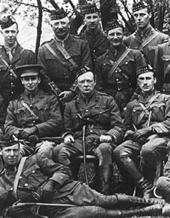
Military tactics before World War I had failed to keep pace with advances in technology. These advances allowed for impressive defence systems, which out-of-date military tactics could not break through for most of the war. Barbed wire was a significant hindrance to massed infantry advances. Artillery, vastly more lethal than in the 1870s, coupled with machine guns, made crossing open ground extremely difficult. The Germans were the first to use lethal poison gas on a large scale; it soon became used by both sides, though it never proved decisive in winning a battle. Its effects were brutal, causing slow and painful death, and poison gas became one of the most-feared and best-remembered horrors of the war. Commanders on both sides failed to develop tactics for breaching entrenched positions without heavy casualties. In time, however, technology began to produce new offensive weapons, such as the tank.
After the First Battle of the Marne (5–12 September 1914), both Entente and German forces began a series of outflanking manoeuvres, in the so-called " Race to the Sea". Britain and France soon found themselves facing entrenched German forces from Lorraine to Belgium's coast. Britain and France sought to take the offensive, while Germany defended the occupied territories. Consequently, German trenches were much better constructed than those of their enemy; Anglo-French trenches were only intended to be "temporary" before their forces broke through German defences.
Both sides tried to break the stalemate using scientific and technological advances. On 22 April 1915, at the Second Battle of Ypres, the Germans (violating the Hague Convention) used chlorine gas for the first time on the Western Front. Algerian troops retreated when gassed and a six-kilometre (four-mile) hole opened in the Allied lines, which the Germans quickly exploited, taking Kitcheners' Wood, before Canadian soldiers closed the breach. Tanks were first used in combat by the British during the Battle of Flers-Courcelette (part of the wider Somme offensive) on 15 September 1916 with only partial success; the French introduced the revolving turret of the Renault FT in late 1917; the Germans employed captured Allied tanks and small numbers of their own design.
Trench warfare continues (1916–1917)
Neither side proved able to deliver a decisive blow for the next two years. Around 1.1 to 1.2 million soldiers from the British and Dominion armies were on the Western Front at any one time. A thousand battalions, occupying sectors of the line from the North Sea to the Orne River, operated on a month-long four-stage rotation system, unless an offensive was underway. The front contained over 9,600 kilometres (5,965 mi) of trenches. Each battalion held its sector for about a week before moving back to support lines and then further back to the reserve lines before a week out-of-line, often in the Poperinge or Amiens areas.
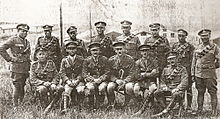
Throughout 1915–17, the British Empire and France suffered more casualties than Germany, because of both the strategic and tactical stances chosen by the sides. Strategically, while the Germans only mounted a single main offensive at Verdun, the Allies made several attempts to break through German lines.
On 1 July 1916, the British Army endured the bloodiest day in its history, suffering 57,470 casualties, including 19,240 dead, on the first day of the Battle of the Somme. Most of the casualties occurred in the first hour of the attack. The entire Somme offensive cost the British Army almost half a million men.
Protracted German action at Verdun throughout 1916, combined with the bloodletting at the Somme (July and August 1916), brought the exhausted French army to the brink of collapse. Futile attempts at frontal assault came at a high price for both the British and the French poilu and led to the widespread French Army Mutinies, after the costly Nivelle Offensive (April and May 1917).
Tactically, German commander Erich Ludendorff's doctrine of " elastic defence" was well suited for trench warfare. This defence had a lightly defended forward position and a more powerful main position farther back beyond artillery range, from which an immediate and powerful counter-offensive could be launched.
Ludendorff wrote on the fighting in 1917,
The 25th of August concluded the second phase of the Flanders battle. It had cost us heavily ... The costly August battles in Flanders and at Verdun imposed a heavy strain on the Western troops. In spite of all the concrete protection they seemed more or less powerless under the enormous weight of the enemy's artillery. At some points they no longer displayed the firmness which I, in common with the local commanders, had hoped for. The enemy managed to adapt himself to our method of employing counter attacks ... I myself was being put to a terrible strain. The state of affairs in the West appeared to prevent the execution of our plans elsewhere. Our wastage had been so high as to cause grave misgivings, and had exceeded all expectation.
On the battle of the Menin Road Ridge, Ludendorff wrote,
Another terrific assault was made on our lines on the 20 September ... The enemy's onslaught on the 20th was successful, which proved the superiority of the attack over the defence. Its strength did not consist in the tanks; we found them inconvenient, but put them out of action all the same. The power of the attack lay in the artillery, and in the fact that ours did not do enough damage to the hostile infantry as they were assembling, and above all, at the actual time of the assault.
In the 1917 Battle of Arras, the only significant British military success was the capture of Vimy Ridge by the Canadian Corps under Sir Arthur Currie and Julian Byng. The assaulting troops could – for the first time – overrun, rapidly reinforce, and hold the ridge defending the coal-rich Douai plain.
At the start of the war, the German Empire had cruisers scattered across the globe, some of which were subsequently used to attack Allied merchant shipping. The British Royal Navy systematically hunted them down, though not without some embarrassment from its inability to protect Allied shipping. For example, the German detached light cruiser SMS Emden, part of the East-Asia squadron stationed at Qingdao, seized or destroyed 15 merchantmen, as well as sinking a Russian cruiser and a French destroyer. However, most of the German East-Asia squadron—consisting of the armoured cruisers Scharnhorst and Gneisenau, light cruisers Nürnberg and Leipzig and two transport ships—did not have orders to raid shipping and was instead underway to Germany when it met British warships. The German flotilla and Dresden sank two armoured cruisers at the Battle of Coronel, but was almost destroyed at the Battle of the Falkland Islands in December 1914, with only Dresden and a few auxiliaries escaping, but at the Battle of Más a Tierra these too were destroyed or interned.
Soon after the outbreak of hostilities, Britain began a naval blockade of Germany. The strategy proved effective, cutting off vital military and civilian supplies, although this blockade violated accepted international law codified by several international agreements of the past two centuries. Britain mined international waters to prevent any ships from entering entire sections of ocean, causing danger to even neutral ships. Since there was limited response to this tactic, Germany expected a similar response to its unrestricted submarine warfare.
The 1916 Battle of Jutland (German: Skagerrakschlacht, or "Battle of the Skagerrak") developed into the largest naval battle of the war, the only full-scale clash of battleships during the war, and one of the largest in history. It took place on 31 May – 1 June 1916, in the North Sea off Jutland. The Kaiserliche Marine's High Seas Fleet, commanded by Vice Admiral Reinhard Scheer, squared off against the Royal Navy's Grand Fleet, led by Admiral Sir John Jellicoe. The engagement was a stand off, as the Germans, outmanoeuvred by the larger British fleet, managed to escape and inflicted more damage to the British fleet than they received. Strategically, however, the British asserted their control of the sea, and the bulk of the German surface fleet remained confined to port for the duration of the war.
German U-boats attempted to cut the supply lines between North America and Britain. The nature of submarine warfare meant that attacks often came without warning, giving the crews of the merchant ships little hope of survival. The United States launched a protest, and Germany changed its rules of engagement. After the sinking of the passenger ship RMS Lusitania in 1915, Germany promised not to target passenger liners, while Britain armed its merchant ships, placing them beyond the protection of the " cruiser rules", which demanded warning and placing crews in "a place of safety" (a standard that lifeboats did not meet). Finally, in early 1917, Germany adopted a policy of unrestricted submarine warfare, realising that the Americans would eventually enter the war. Germany sought to strangle Allied sea lanes before the U.S. could transport a large army overseas, but could maintain only five long-range U-boats on station, to limited effect.
The U-boat threat lessened in 1917, when merchant ships began travelling in convoys, escorted by destroyers. This tactic made it difficult for U-boats to find targets, which significantly lessened losses; after the hydrophone and depth charges were introduced, accompanying destroyers might attack a submerged submarine with some hope of success. Convoys slowed the flow of supplies, since ships had to wait as convoys were assembled. The solution to the delays was an extensive program of building new freighters. Troopships were too fast for the submarines and did not travel the North Atlantic in convoys. The U-boats had sunk more than 5,000 Allied ships, at a cost of 199 submarines.
World War I also saw the first use of aircraft carriers in combat, with HMS Furious launching Sopwith Camels in a successful raid against the Zeppelin hangars at Tondern in July 1918, as well as blimps for antisubmarine patrol.
Southern theatres
War in the Balkans
Faced with Russia, Austria-Hungary could spare only one-third of its army to attack Serbia. After suffering heavy losses, the Austrians briefly occupied the Serbian capital, Belgrade. A Serbian counterattack in the battle of Kolubara, however, succeeded in driving them from the country by the end of 1914. For the first ten months of 1915, Austria-Hungary used most of its military reserves to fight Italy. German and Austro-Hungarian diplomats, however, scored a coup by persuading Bulgaria to join the attack on Serbia. The Austro-Hungarian provinces of Slovenia, Croatia and Bosnia provided troops for Austria-Hungary, invading Serbia as well as fighting Russia and Italy. Montenegro allied itself with Serbia.
Serbia was conquered in a little more than a month, as the Central Powers, now including Bulgaria, sent in 600,000 troops. The Serbian army, fighting on two fronts and facing certain defeat, retreated into northern Albania (which they had invaded at the beginning of the war). The Serbs suffered defeat in the Battle of Kosovo. Montenegro covered the Serbian retreat towards the Adriatic coast in the Battle of Mojkovac in 6–7 January 1916, but ultimately the Austrians conquered Montenegro, too. The 70,000 surviving Serbian soldiers were evacuated by ship to Greece.
In late 1915, a Franco-British force landed at Salonica in Greece, to offer assistance and to pressure the government to declare war against the Central Powers. Unfortunately for the Allies, the pro-German King Constantine I dismissed the pro-Allied government of Eleftherios Venizelos before the Allied expeditionary force could arrive. The friction between the King of Greece and the Allies continued to accumulate with the National Schism, which effectively divided Greece between regions still loyal to the king and the new provisional government of Venizelos in Salonica. After intensive diplomatic negotiations and an armed confrontation in Athens between Allied and royalist forces (an incident known as Noemvriana), the King of Greece resigned, and his second son Alexander took his place. Venizelos returned to Athens on 29 May 1917 and Greece, now unified, officially joined the war on the side of the Allies. The entire Greek army was mobilized and began to participate in military operations against the Central Powers on the Macedonian Front.
After conquest, Serbia was divided between Austro-Hungary and Bulgaria. In 1917, the Serbs launched the Toplica Uprising and, for a short time, liberated the area between the Kopaonik mountains and the South Morava river. The uprising was crushed by the joint effort of Bulgarian and Austrian forces at the end of March 1917.
In the beginning, the Macedonian Front was mostly static. French and Serbian forces retook limited areas of Macedonia by recapturing Bitola on 19 November 1916 following the costly Monastir Offensive, which brought stabilization of the front.
Serbian and French troops finally made a breakthrough, after most of the German and Austro-Hungarian troops had withdrawn. This breakthrough was significant in defeating Bulgaria and Austro-Hungary, which led to the final victory of WWI. The Bulgarians suffered their only defeat of the war at the Battle of Dobro Pole, but, days later, they decisively defeated British and Greek forces at the Battle of Doiran, avoiding occupation. After the Serbian breakthrough of Bulgarian lines, Bulgaria capitulated on 29 September 1918. Hindenburg and Ludendorff concluded that the strategic and operational balance had now shifted decidedly against the Central Powers and a day after the Bulgarian collapse, during a meeting with government officials, insisted on an immediate peace settlement.
The disappearance of the Macedonian Front meant that the road to Budapest and Vienna was now opened for the 670,000-strong army of general Franchet d'Esperey as the Bulgarian surrender deprived the Central Powers of the 278 infantry battalions and 1,500 guns (the equivalent of some 25 to 30 German divisions) that were previously holding the line. The German high command responded by sending only seven infantry and one cavalry division, but these forces were far too weak to reestablish a front.
Ottoman Empire
The Ottoman Empire joined the Central Powers in the war, the secret Ottoman-German Alliance having been signed in August 1914. It threatened Russia's Caucasian territories and Britain's communications with India via the Suez Canal. The British and French opened overseas fronts with the Gallipoli (1915) and Mesopotamian campaigns. In Gallipoli, the Ottoman Empire successfully repelled the British, French, and Australian and New Zealand Army Corps (ANZACs). In Mesopotamia, by contrast, after the disastrous Siege of Kut (1915–16), British Imperial forces reorganised and captured Baghdad in March 1917.
Further to the west, the Suez Canal was successfully defended from Ottoman attacks in 1915 and 1916; in August, a joint German and Ottoman force was defeated at the Battle of Romani by the Anzac Mounted and the 52nd (Lowland) Infantry Divisions. Following this victory, a British Empire Egyptian Expeditionary Force advanced across the Sinai Peninsula, pushing Ottoman forces back in the Battle of Magdhaba in December and the Battle of Rafa on the border between the Egyptian Sinai and Ottoman Palestine in January 1917.
Russian armies generally had the best of it in the Caucasus. Enver Pasha, supreme commander of the Ottoman armed forces, was ambitious and dreamed of re-conquering central Asia and areas that had been lost to Russia previously. He was, however, a poor commander. He launched an offensive against the Russians in the Caucasus in December 1914 with 100,000 troops; insisting on a frontal attack against mountainous Russian positions in winter, he lost 86% of his force at the Battle of Sarikamish.
General Yudenich, the Russian commander from 1915 to 1916, drove the Turks out of most of the southern Caucasus with a string of victories. In 1917, Russian Grand Duke Nicholas assumed command of the Caucasus front. Nicholas planned a railway from Russian Georgia to the conquered territories, so that fresh supplies could be brought up for a new offensive in 1917. However, in March 1917 (February in the pre-revolutionary Russian calendar), the Czar was overthrown in the February Revolution and the Russian Caucasus Army began to fall apart.
Instigated by the Arab bureau of the British Foreign Office, the Arab Revolt started with the help of Britain in June 1916 at the Battle of Mecca, led by Sherif Hussein of Mecca, and ended with the Ottoman surrender of Damascus. Fakhri Pasha, the Ottoman commander of Medina, resisted for more than two and half years during the Siege of Medina.
Along the border of Italian Libya and British Egypt, the Senussi tribe, incited and armed by the Turks, waged a small-scale guerrilla war against Allied troops. The British were forced to dispatch 12,000 troops to oppose them in the Senussi Campaign. Their rebellion was finally crushed in mid-1916.
| Name of Allied country | Number of troops deployed on Ottomans fronts |
|---|---|
| Great Britain | 2,550,000 men deployed (32% of the total British armed forces), at one point 880,300 British soldiers were fighting the Ottomans (24% of total.) |
| Russian Empire | 702,000 men (19% of total army) were fighting the Ottomans in the Caucasus Front by September 1916. |
| France | 50,000 men were fighting at the Dardanelles |
| Kingdom of Italy | 70,000 expeditionary force in Italian Libya to quell an Ottoman supported revolt. |
Total Allied casualties on the Ottoman fronts amounted 650,000 men. Total Ottoman casualties were 725,000 (325,000 dead and 400,000 wounded).
Italian participation
Italy had been allied with the German and Austro-Hungarian Empires since 1882 as part of the Triple Alliance. However, the nation had its own designs on Austrian territory in Trentino, Istria, and Dalmatia. Rome had a secret 1902 pact with France, effectively nullifying its alliance. At the start of hostilities, Italy refused to commit troops, arguing that the Triple Alliance was defensive and that Austria–Hungary was an aggressor. The Austro-Hungarian government began negotiations to secure Italian neutrality, offering the French colony of Tunisia in return. The Allies made a counter-offer in which Italy would receive the Southern Tyrol, Julian March and territory on the Dalmatian coast after the defeat of Austria-Hungary. This was formalised by the Treaty of London. Further encouraged by the Allied invasion of Turkey in April 1915, Italy joined the Triple Entente and declared war on Austria-Hungary on 23 May. Fifteen months later, Italy declared war on Germany.
Militarily, the Italians had numerical superiority. This advantage, however, was lost, not only because of the difficult terrain in which fighting took place, but also because of the strategies and tactics employed. Field Marshal Luigi Cadorna, a staunch proponent of the frontal assault, had dreams of breaking into the Slovenian plateau, taking Ljubljana and threatening Vienna. Cadorna's plan did not take into account the difficulties of the rugged Alpine terrain, or the technological changes that created trench warfare, giving rise to a series of bloody and inconclusive stalemated offensives.
On the Trentino front, the Austro-Hungarians took advantage of the mountainous terrain, which favoured the defender. After an initial strategic retreat, the front remained largely unchanged, while Austrian Kaiserschützen and Standschützen engaged Italian Alpini in bitter hand-to-hand combat throughout the summer. The Austro-Hungarians counterattacked in the Altopiano of Asiago, towards Verona and Padua, in the spring of 1916 ( Strafexpedition), but made little progress.
Beginning in 1915, the Italians under Cadorna mounted eleven offensives on the Isonzo front along the Isonzo River, northeast of Trieste. All eleven offensives were repelled by the Austro-Hungarians, who held the higher ground. In the summer of 1916, the Italians captured the town of Gorizia. After this minor victory, the front remained static for over a year, despite several Italian offensives. In the autumn of 1917, thanks to the improving situation on the Eastern front, the Austro-Hungarian troops received large numbers of reinforcements, including German Stormtroopers and the elite Alpenkorps.
The Central Powers launched a crushing offensive on 26 October 1917, spearheaded by the Germans. They achieved a victory at Caporetto. The Italian Army was routed and retreated more than 100 kilometres (62 mi) to reorganise, stabilising the front at the Piave River. Since the Italian Army had suffered heavy losses in the Battle of Caporetto, the Italian Government called to arms the so-called '99 Boys (Ragazzi del '99): that is, all males who were 18 years old. In 1918, the Austro-Hungarians failed to break through in a series of battles on the Piave River, and were finally decisively defeated in the Battle of Vittorio Veneto in October of that year. From 5–6 November 1918, Italian forces were reported to have reached Lissa, Lagosta, Sebenico, and other localities on the Dalmatian coast. By the end of hostilities in November 1918, the Italian military had seized control of the entire portion of Dalmatia that had been guaranteed to Italy by the London Pact. In 1918, Admiral Enrico Millo declared himself Italy's Governor of Dalmatia. Austria-Hungary surrendered in early November 1918.
Romanian participation
Romania had been allied with the Central Powers since 1882. When the war began, however, it declared its neutrality, arguing that because Austria-Hungary had itself declared war on Serbia, Romania was under no obligation to join the war. When the Entente Powers promised Romania large territories of eastern Hungary ( Transylvania and Banat), which had a large Romanian population, in exchange for Romania's declaring war on the Central Powers, the Romanian government renounced its neutrality and, on 27 August 1916, the Romanian Army launched an attack against Austria-Hungary, with limited Russian support. The Romanian offensive was initially successful, pushing back the Austro-Hungarian troops in Transylvania, but a counterattack by the forces of the Central Powers drove back the Russo-Romanian forces. As a result of the Battle of Bucharest, the Central Powers occupied Bucharest on 6 December 1916. Fighting in Moldova continued in 1917, resulting in a costly stalemate for the Central Powers. Russian withdrawal from the war in late 1917 as a result of the October Revolution meant that Romania was forced to sign an armistice with the Central Powers on 9 December 1917.
In January 1918, Romanian forces established control over Bessarabia as the Russian Army abandoned the province. Although a treaty was signed by the Romanian and the Bolshevik Russian government following talks from 5–9 March 1918 on the withdrawal of Romanian forces from Bessarabia within two months, on 27 March 1918 Romania attached Bessarabia to its territory, formally based on a resolution passed by the local assembly of the territory on the unification with Romania.
Romania officially made peace with the Central Powers by signing the Treaty of Bucharest on 7 May 1918. Under that treaty, Romania was obliged to end the war with the Central Powers and make small territorial concessions to Austria-Hungary, ceding control of some passes in the Carpathian Mountains, and grant oil concessions to Germany. In exchange, the Central Powers recognised the sovereignty of Romania over Bessarabia. The treaty was renounced in October 1918 by the Alexandru Marghiloman government, and Romania nominally re-entered the war on 10 November 1918. The next day, the Treaty of Bucharest was nullified by the terms of the Armistice of Compiègne. Total Romanian deaths from 1914 to 1918, military and civilian, within contemporary borders, were estimated at 748,000.
The role of India
Contrary to British fears of a revolt in India, the outbreak of the war saw an unprecedented outpouring of loyalty and goodwill towards the United Kingdom. Indian political leaders from the Indian National Congress and other groups were eager to support the British war effort, since they believed that strong support for the war effort would further the cause of Indian Home Rule. The Indian Army in fact outnumbered the British Army at the beginning of the war; about 1.3 million Indian soldiers and labourers served in Europe, Africa, and the Middle East, while both the central government and the princely states sent large supplies of food, money, and ammunition. In all, 140,000 men served on the Western Front and nearly 700,000 in the Middle East. Casualties of Indian soldiers totalled 47,746 killed and 65,126 wounded during World War I. The suffering engendered by the war, as well as the failure of the British government to grant self-government to India after the end of hostilities, bred disillusionment and fuelled the campaign for full independence that would be led by Mohandas Karamchand Gandhi and others.
Eastern Front
Initial actions
While the Western Front had reached stalemate, the war continued in East Europe. Initial Russian plans called for simultaneous invasions of Austrian Galicia and German East Prussia. Although Russia's initial advance into Galicia was largely successful, it was driven back from East Prussia by Hindenburg and Ludendorff at Tannenberg and the Masurian Lakes in August and September 1914. Russia's less developed industrial base and ineffective military leadership was instrumental in the events that unfolded. By the spring of 1915, the Russians had retreated to Galicia, and, in May, the Central Powers achieved a remarkable breakthrough on Poland's southern frontiers. On 5 August, they captured Warsaw and forced the Russians to withdraw from Poland.
Russian Revolution
Despite the success of the June 1916 Brusilov Offensive in eastern Galicia, dissatisfaction with the Russian government's conduct of the war grew. The offensive's success was undermined by the reluctance of other generals to commit their forces to support the victory. Allied and Russian forces were revived only temporarily by Romania's entry into the war on 27 August. German forces came to the aid of embattled Austro-Hungarian units in Transylvania, and Bucharest fell to the Central Powers on 6 December. Meanwhile, unrest grew in Russia, as the Tsar remained at the front. Empress Alexandra's increasingly incompetent rule drew protests and resulted in the murder of her favourite, Rasputin, at the end of 1916.
In March 1917, demonstrations in Petrograd culminated in the abdication of Tsar Nicholas II and the appointment of a weak Provisional Government, which shared power with the Petrograd Soviet socialists. This arrangement led to confusion and chaos both at the front and at home. The army became increasingly ineffective.
Discontent and the weaknesses of the Provisional Government led to a rise in the popularity of the Bolshevik Party, led by Vladimir Lenin, which demanded an immediate end to the war. The successful armed uprising by the Bolsheviks of November was followed in December by an armistice and negotiations with Germany. At first, the Bolsheviks refused the German terms, but when German troops began marching across the Ukraine unopposed, the new government acceded to the Treaty of Brest-Litovsk on 3 March 1918. The treaty ceded vast territories, including Finland, the Baltic provinces, parts of Poland and Ukraine to the Central Powers. Despite this enormous apparent German success, the manpower required for German occupation of former Russian territory may have contributed to the failure of the Spring Offensive and secured relatively little food or other materiel.
With the adoption of the Treaty of Brest-Litovsk, the Entente no longer existed. The Allied powers led a small-scale invasion of Russia, partly to stop Germany from exploiting Russian resources and, to a lesser extent, to support the "Whites" (as opposed to the "Reds") in the Russian Civil War. Allied troops landed in Arkhangelsk and in Vladivostok.
Central Powers proposal for starting peace negotiations
In December 1916, after ten brutal months of the Battle of Verdun and a successful offensive against Romania, the Germans attempted to negotiate a peace with the Allies. Soon after, U.S. President Woodrow Wilson attempted to intervene as a peacemaker, asking in a note for both sides to state their demands. Lloyd George's War Cabinet considered the German offer to be a ploy to create divisions amongst the Allies. After initial outrage and much deliberation, they took Wilson's note as a separate effort, signalling that the U.S. was on the verge of entering the war against Germany following the "submarine outrages". While the Allies debated a response to Wilson's offer, the Germans chose to rebuff it in favour of "a direct exchange of views". Learning of the German response, the Allied governments were free to make clear demands in their response of 14 January. They sought restoration of damages, the evacuation of occupied territories, reparations for France, Russia and Romania, and a recognition of the principle of nationalities. This included the liberation of Italians, Slavs, Romanians, Czecho-Slovaks, and the creation of a "free and united Poland". On the question of security, the Allies sought guarantees that would prevent or limit future wars, complete with sanctions, as a condition of any peace settlement. The negotiations failed and the Entente powers rejected the German offer, because Germany did not state any specific proposals. To Wilson, the Entente powers stated that they would not start peace negotiations until the Central powers evacuated all occupied Allied territories and provided indemnities for all damage which had been done.
1917–1918
Developments in 1917
Events of 1917 proved decisive in ending the war, although their effects were not fully felt until 1918.
The British naval blockade began to have a serious impact on Germany. In response, in February 1917, the German General Staff convinced Chancellor Theobald von Bethmann-Hollweg to declare unrestricted submarine warfare, with the goal of starving Britain out of the war. German planners estimated that unrestricted submarine warfare would cost Britain a monthly shipping loss of 600,000 tons. The General Staff acknowledged that the policy would almost certainly bring the United States into the conflict, but calculated that British shipping losses would be so high that they would be forced to sue for peace after 5 to 6 months, before American intervention could make an impact. In reality, tonnage sunk rose above 500,000 tons per month from February to July. It peaked at 860,000 tons in April. After July, the newly re-introduced convoy system became extremely effective in reducing the U-boat threat. Britain was safe from starvation, while German industrial output fell and the United States troops joined the war in large numbers far earlier than Germany had anticipated.
On 3 May 1917, during the Nivelle Offensive, the weary French 2nd Colonial Division, veterans of the Battle of Verdun, refused their orders, arriving drunk and without their weapons. Their officers lacked the means to punish an entire division, and harsh measures were not immediately implemented. Then, the French Army Mutinies afflicted an additional 54 French divisions and saw 20,000 men desert. The other Allied forces attacked, but sustained tremendous casualties. However, appeals to patriotism and duty, as well as mass arrests and trials, encouraged the soldiers to return to defend their trenches, although the French soldiers refused to participate in further offensive action. Robert Nivelle was removed from command by 15 May, replaced by General Philippe Pétain, who suspended bloody large-scale attacks.
The victory of Austria–Hungary and Germany at the Battle of Caporetto, led the Allies to convenve the Rapallo Conference at which they formed the Supreme War Council to coordinate planning. Previously, British and French armies had operated under separate commands.
In December, the Central Powers signed an armistice with Russia. This released large numbers of German troops for use in the west. With German reinforcements and new American troops pouring in, the outcome was to be decided on the Western Front. The Central Powers knew that they could not win a protracted war, but they held high hopes for success based on a final quick offensive. Furthermore, the leaders of the Central Powers and the Allies became increasingly fearful of social unrest and revolution in Europe. Thus, both sides urgently sought a decisive victory.
Ottoman Empire conflict in 1917
In March and April 1917, at the First and Second Battles of Gaza, German and Ottoman forces stopped the advance of the Egyptian Expeditionary Force, which had begun in August 1916 at Romani. At the end of October, the Sinai and Palestine Campaign resumed, when General Edmund Allenby's XXth Corps, XXI Corps and Desert Mounted Corps won the Battle of Beersheba. Two Ottoman armies were defeated a few weeks later at the Battle of Mughar Ridge and, early in December, Jerusalem was captured following another Ottoman defeat at the Battle of Jerusalem (1917). About this time, Friedrich Freiherr Kress von Kressenstein was relieved of his duties as the Eighth Army's commander, replaced by Djevad Pasha, and a few months later the commander of the Ottoman Army in Palestine, Erich von Falkenhayn, was replaced by Otto Liman von Sanders.
Entry of the United States
Non-intervention
At the outbreak of the war, the United States pursued a policy of non-intervention, avoiding conflict while trying to broker a peace. When a German U-boat sank the British liner RMS Lusitania on 7 May 1915 with 128 Americans among the dead, President Woodrow Wilson insisted that "America is too proud to fight" but demanded an end to attacks on passenger ships. Germany complied. Wilson unsuccessfully tried to mediate a settlement. However, he also repeatedly warned that the U.S.A. would not tolerate unrestricted submarine warfare, in violation of international law. Former president Theodore Roosevelt denounced German acts as "piracy". Wilson was narrowly reelected in 1916 as his supporters emphasized "he kept us out of war".
In January 1917, Germany resumed unrestricted submarine warfare, realizing it would mean American entry. The German Foreign Minister, in the Zimmermann Telegram, invited Mexico to join the war as Germany's ally against the United States. In return, the Germans would finance Mexico's war and help it recover the territories of Texas, New Mexico, and Arizona. Wilson released the Zimmerman note to the public, and Americans saw it as casus belli—a cause for war. Wilson called on antiwar elements to end all wars, by winning this one and eliminating militarism from the globe. He argued that the war was so important that the U.S. had to have a voice in the peace conference.

U.S. declaration of war on Germany
After the sinking of seven U.S. merchant ships by submarines and the publication of the Zimmerman telegram, Wilson called for war on Germany, which the U.S. Congress declared on 6 April 1917.
First active U.S. participation
The United States was never formally a member of the Allies but became a self-styled "Associated Power". The United States had a small army, but, after the passage of the Selective Service Act, it drafted 2.8 million men, and, by summer 1918, was sending 10,000 fresh soldiers to France every day. In 1917, the U.S. Congress gave U.S. citizenship to Puerto Ricans when they were drafted to participate in World War I, as part of the Jones Act. Germany had miscalculated, believing it would be many more months before American soldiers would arrive and that their arrival could be stopped by U-boats.
The United States Navy sent a battleship group to Scapa Flow to join with the British Grand Fleet, destroyers to Queenstown, Ireland, and submarines to help guard convoys. Several regiments of U.S. Marines were also dispatched to France. The British and French wanted U.S. units used to reinforce their troops already on the battle lines and not waste scarce shipping on bringing over supplies. The U.S. rejected the first proposition and accepted the second. General John J. Pershing, American Expeditionary Forces (AEF) commander, refused to break up U.S. units to be used as reinforcements for British Empire and French units. As an exception, he did allow African-American combat regiments to be used in French divisions. The Harlem Hellfighters fought as part of the French 16th Division, earning a unit Croix de Guerre for their actions at Château-Thierry, Belleau Wood, and Sechault. AEF doctrine called for the use of frontal assaults, which had long since been discarded by British Empire and French commanders because of the large loss of life.
Austrian offer of separate peace
In 1917, Emperor Charles I of Austria secretly attempted separate peace negotiations with Clemenceau, with his wife's brother Sixtus in Belgium as an intermediary, without the knowledge of Germany. When the negotiations failed, his attempt was revealed to Germany, resulting in a diplomatic catastrophe.
German Spring Offensive of 1918
German General Erich Ludendorff drew up plans ( codenamed Operation Michael) for the 1918 offensive on the Western Front. The Spring Offensive sought to divide the British and French forces with a series of feints and advances. The German leadership hoped to strike a decisive blow before significant U.S. forces arrived. The operation commenced on 21 March 1918, with an attack on British forces near Amiens. German forces achieved an unprecedented advance of 60 kilometres (37 mi).
British and French trenches were penetrated using novel infiltration tactics, also named Hutier tactics, after General Oskar von Hutier. Previously, attacks had been characterised by long artillery bombardments and massed assaults. However, in the Spring Offensive of 1918, Ludendorff used artillery only briefly and infiltrated small groups of infantry at weak points. They attacked command and logistics areas and bypassed points of serious resistance. More heavily armed infantry then destroyed these isolated positions. German success relied greatly on the element of surprise.
The front moved to within 120 kilometres (75 mi) of Paris. Three heavy Krupp railway guns fired 183 shells on the capital, causing many Parisians to flee. The initial offensive was so successful that Kaiser Wilhelm II declared 24 March a national holiday. Many Germans thought victory was near. After heavy fighting, however, the offensive was halted. Lacking tanks or motorised artillery, the Germans were unable to consolidate their gains. This situation was not helped by the supply lines now being stretched as a result of their advance. The sudden stop was also a result of the four Australian Imperial Force (AIF) divisions that were "rushed" down, thus doing what no other army had done: stopping the German advance in its tracks. During that time, the 1st Australian Division was hurriedly sent back north to stop the second German breakthrough.
General Foch pressed to use the arriving American troops as individual replacements, whereas Pershing sought to field American units as an independent force. These units were assigned to the depleted French and British Empire commands on 28 March. A Supreme War Council of Allied forces was created at the Doullens Conference on 5 November 1917. General Foch was appointed as supreme commander of the allied forces. Haig, Petain, and Pershing retained tactical control of their respective armies; Foch assumed a coordinating rather than a directing role, and the British, French, and U.S. commands operated largely independently.
Following Operation Michael, Germany launched Operation Georgette against the northern English Channel ports. The Allies halted the drive after limited territorial gains by Germany. The German Army to the south then conducted Operations Blücher and Yorck, pushing broadly towards Paris. Operation Marne was launched on 15 July, attempting to encircle Reims and beginning the Second Battle of the Marne. The resulting counterattack, starting the Hundred Days Offensive, marked the first successful Allied offensive of the war.
By 20 July, the Germans were back across the Marne at their Kaiserschlacht starting lines, having achieved nothing. Following this last phase of the war in the West, the German Army never regained the initiative. German casualties between March and April 1918 were 270,000, including many highly trained storm troopers.
Meanwhile, Germany was falling apart at home. Anti-war marches became frequent and morale in the army fell. Industrial output was 53 percent of 1913 levels.
Ottoman Empire conflict 1918
Early in 1918, the front line was extended into the Jordan Valley, which continued to be occupied, following the First Transjordan and the Second Transjordan attack by British Empire forces in March and April 1918, into the summer. During March, most of the Egyptian Expeditionary Force's British infantry and Yeomanry cavalry were sent to fight on the Western Front as a consequence of the Spring Offensive. They were replaced by Indian Army units. During several months of reorganisation and training during the summer, a number of attacks were carried out on sections of the Ottoman front line. These pushed the front line north to more advantageous positions in preparation for an attack and to acclimatise the newly arrived Indian Army infantry. It was not until the middle of September that the integrated force was ready for large-scale operations.
The reorganised Egyptian Expeditionary Force, with an additional mounted division, broke Ottoman forces at the Battle of Megiddo in September 1918. In two days the British and Indian infantry supported by a creeping barrage broke the Ottoman front line and captured the headquarters of the Eighth Army (Ottoman Empire) at Tulkarm, the continuous trench lines at Tabsor, Arara and the Seventh Army (Ottoman Empire) headquarters at Nablus. The Desert Mounted Corps rode through the break in the front line created by the infantry and, during virtually continuous operations by Australian Light Horse, British mounted Yeomanry, Indian Lancers and New Zealand Mounted Rifle brigades in the Jezreel Valley, they captured Nazareth, Afulah and Beisan, Jenin, along with Haifa on the Mediterranean coast and Daraa east of the Jordan River on the Hejaz railway. Samakh and Tiberias on the Sea of Galilee, were captured on the way northwards to Damascus. Meanwhile, Chaytor's Force of Australian light horse, New Zealand mounted rifles, Indian, British West Indies and Jewish infantry captured the crossings of the Jordan River, Es Salt, Amman and at Ziza most of the Fourth Army (Ottoman Empire). The Armistice of Mudros, signed at the end of October ended hostilities with the Ottoman Empire when fighting was continuing north of Aleppo.
New states under war zone
In the late spring of 1918, three new states were formed in the South Caucasus: the Democratic Republic of Armenia, the Azerbaijan Democratic Republic, and the Democratic Republic of Georgia, which declared their independence from the Russian Empire. Two other minor entities were established, the Centrocaspian Dictatorship and South West Caucasian Republic (the former was liquidated by Azerbaijan in the autumn of 1918 and the latter by a joint Armenian-British task force in early 1919). With the withdrawal of the Russian armies from the Caucasus front in the winter of 1917–18, the three major republics braced for an imminent Ottoman advance, which commenced in the early months of 1918. Solidarity was briefly maintained when the Transcaucasian Federative Republic was created in the spring of 1918, but this collapsed in May, when the Georgians asked and received protection from Germany and the Azerbaijanis concluded a treaty with the Ottoman Empire that was more akin to a military alliance. Armenia was left to fend for itself and struggled for five months against the threat of a full-fledged occupation by the Ottoman Turks.
Allied victory: summer and autumn 1918
The Allied counteroffensive, known as the Hundred Days Offensive, began on 8 August 1918. The Battle of Amiens developed with III Corps British Fourth Army on the left, the French First Army on the right, and the Australian and Canadian Corps spearheading the offensive in the centre through Harbonnières. It involved 414 tanks of the Mark IV and Mark V type, and 120,000 men. They advanced 12 kilometres (7.5 mi) into German-held territory in just seven hours. Erich Ludendorff referred to this day as the "Black Day of the German army".
The Australian-Canadian spearhead at Amiens, a battle that was the beginning of Germany's downfall, helped pull forward the British armies to the north and the French armies to the south. On the British Fourth Army front at Amiens, after an advance as far as 14 miles (23 km), German resistance stiffened, and the battle there concluded. But the French Third Army lengthened the Amiens front on 10 August, when it was thrown in on the right of the French First Army, and advanced 4 miles (6 km), liberating Lassigny in fighting which lasted until 16 August. South of the French Third Army, General Charles Mangin (The Butcher) drove his French Tenth Army forward at Soissons on 20 August to capture eight thousand prisoners, two hundred guns, and the Aisne heights overlooking and menacing the German position north of the Vesle. Another "Black day", as described by Erich Ludendorff.
Meanwhile, General Byng of the British Third Army, reporting that the enemy on his front was thinning in a limited withdrawal, was ordered to attack with 200 tanks towards Bapaume, opening the Battle of Albert, with specific orders "To break the enemy's front, in order to outflank the enemy's present battle front" (opposite the British Fourth Army at Amiens). Allied leaders had now realised that to continue an attack after resistance had hardened was a waste of lives, and it was better to turn a line than to try to roll over it. They began to undertake attacks in quick order to take advantage of successful advances on the flanks, then broke them off when each attack lost its initial impetus.
The British Third Army's 15-mile (24 km) front north of Albert progressed after stalling for a day against the main resistance line to which the enemy had withdrawn. Rawlinson's British Fourth Army was able to push its left flank forward between Albert and the Somme, straightening the line between the advanced positions of the Third Army and the Amiens front, which resulted in recapturing Albert at the same time. On 26 August the British First Army on the left of the Third Army was drawn into the battle, extending it northward to beyond Arras. The Canadian Corps, already back in the vanguard of the First Army, fought its way from Arras eastward 5 miles (8 km) astride the heavily defended Arras-Cambrai area before reaching the outer defences of the Hindenburg Line, breaching them on the 28 and 29 August. Bapaume fell on 29 August to the New Zealand Division of the Third Army, and the Australians, still leading the advance of the Fourth Army, were again able to push forward at Amiens to take Peronne and Mont Saint-Quentin on 31 August. Further south, the French First and Third Armies had slowly fought forward while the Tenth Army, which had by now crossed the Ailette and was east of the Chemin des Dames, neared the Alberich position of the Hindenburg Line. During the last week of August the pressure along a 70-mile (113 km) front against the enemy was heavy and unrelenting. From German accounts, "Each day was spent in bloody fighting against an ever and again on-storming enemy, and nights passed without sleep in retirements to new lines." Even to the north in Flanders the British Second and Fifth Armies during August and September were able to make progress, taking prisoners and positions that had previously been denied them.
On 2 September, the Canadian Corps' outflanking of the Hindenburg line, with the breaching of the Wotan Position, made it possible for the Third Army to advance, which sent repercussions all along the Western Front. That same day, Oberste Heeresleitung (OHL) had no choice but to issue orders to six armies to withdraw back into the Hindenburg Line in the south, behind the Canal du Nord on the Canadian-First Army's front and back to a line east of the Lys in the north. This ceded without a fight the salient seized the previous April. According to Ludendorff "We had to admit the necessity ...to withdraw the entire front from the Scarpe to the Vesle."
In nearly four weeks of fighting beginning 8 August, over 100,000 German prisoners were taken, 75,000 by the BEF and the rest by the French. As of "The Black Day of the German Army", the German High Command realised that the war was lost and made attempts to reach a satisfactory end. The day after that battle, Ludenforff told Colonel Mertz: "We cannot win the war any more, but we must not lose it either." On 11 August he offered his resignation to the Kaiser, who refused it, replying, "I see that we must strike a balance. We have nearly reached the limit of our powers of resistance. The war must be ended." On 13 August, at Spa, Hindenburg, Ludendorff, the Chancellor, and Foreign Minister Hintz agreed that the war could not be ended militarily and, on the following day, the German Crown Council decided that victory in the field was now most improbable. Austria and Hungary warned that they could only continue the war until December, and Ludendorff recommended immediate peace negotiations, to which the Kaiser responded by instructing Hintz to seek the mediation of the Queen of the Netherlands. Prince Rupprecht warned Prince Max of Baden: "Our military situation has deteriorated so rapidly that I no longer believe we can hold out over the winter; it is even possible that a catastrophe will come earlier." On 10 September Hindenburg urged peace moves to Emperor Charles of Austria, and Germany appealed to the Netherlands for mediation. On 14 September Austria sent a note to all belligerents and neutrals suggesting a meeting for peace talks on neutral soil, and on 15 September Germany made a peace offer to Belgium. Both peace offers were rejected, and on 24 September OHL informed the leaders in Berlin that armistice talks were inevitable.
September saw the Germans continuing to fight strong rear-guard actions and launching numerous counterattacks on lost positions, but only a few succeeded, and then only temporarily. Contested towns, villages, heights, and trenches in the screening positions and outposts of the Hindenburg Line continued to fall to the Allies, with the BEF alone taking 30,441 prisoners in the last week of September. Further small advances eastward would follow the Third Army's victory at Ivincourt on 12 September, the Fourth Army's at Epheny on 18 September, and the French gain of Essigny-le-Grand a day later. On 24 September a final assault by both the British and French on a 4-mile (6.4 km) front would come within 2 miles (3.2 km) of St. Quentin. With the outposts and preliminary defensive lines of the Siegfried and Alberich Positions eliminated, the Germans were now completely back in the Hindenburg Line. With the Wotan position of that line already breached and the Siegfried position in danger of being turned from the north, the time had now come for an Allied assault on the whole length of the line.
The Allied attack on the Hindenburg Line, begun on 26 September, included U.S. soldiers. The still-green American troops suffered problems coping with supply trains for large units on a difficult landscape. The following week, cooperating French and American units broke through in Champagne at the Battle of Blanc Mont Ridge, forcing the Germans off the commanding heights, and closing towards the Belgian frontier. The last Belgian town to be liberated before the armistice was Ghent, which the Germans held as a pivot until the Allies brought up artillery. The German army had to shorten its front and use the Dutch frontier as an anchor to fight rear-guard actions.
When Bulgaria signed a separate armistice on 29 September, the Allies gained control of Serbia and Greece. Ludendorff, having been under great stress for months, suffered something similar to a breakdown. It was evident that Germany could no longer mount a successful defence.
Meanwhile, news of Germany's impending military defeat spread throughout the German armed forces. The threat of mutiny was rife. Admiral Reinhard Scheer and Ludendorff decided to launch a last attempt to restore the "valour" of the German Navy. Knowing the government of Prince Maximilian of Baden would veto any such action, Ludendorff decided not to inform him. Nonetheless, word of the impending assault reached sailors at Kiel. Many, refusing to be part of a naval offensive, which they believed to be suicidal, rebelled and were arrested. Ludendorff took the blame; the Kaiser dismissed him on 26 October. The collapse of the Balkans meant that Germany was about to lose its main supplies of oil and food. Its reserves had been used up, even as U.S. troops kept arriving at the rate of 10,000 per day.
Having suffered over 6 million casualties, Germany moved towards peace. Prince Maximilian of Baden took charge of a new government as Chancellor of Germany to negotiate with the Allies. Telegraphic negotiations with President Wilson began immediately, in the vain hope that he would offer better terms than the British and French. Instead, Wilson demanded the abdication of the Kaiser. There was no resistance when the Social Democrat Philipp Scheidemann on 9 November declared Germany to be a republic. Imperial Germany was dead; a new Germany had been born: the Weimar Republic.
Armistices and capitulations


The collapse of the Central Powers came swiftly. Bulgaria was the first to sign an armistice, on 29 September 1918 at Saloniki. On 30 October, the Ottoman Empire capitulated at Moudros ( Armistice of Mudros).
On 24 October, the Italians began a push that rapidly recovered territory lost after the Battle of Caporetto. This culminated in the Battle of Vittorio Veneto, which marked the end of the Austro-Hungarian Army as an effective fighting force. The offensive also triggered the disintegration of the Austro-Hungarian Empire. During the last week of October, declarations of independence were made in Budapest, Prague, and Zagreb. On 29 October, the imperial authorities asked Italy for an armistice. But the Italians continued advancing, reaching Trento, Udine, and Trieste. On 3 November, Austria–Hungary sent a flag of truce to ask for an Armistice. The terms, arranged by telegraph with the Allied Authorities in Paris, were communicated to the Austrian commander and accepted. The Armistice with Austria was signed in the Villa Giusti, near Padua, on 3 November. Austria and Hungary signed separate armistices following the overthrow of the Habsburg Monarchy.
Following the outbreak of the German Revolution of 1918–1919, a republic was proclaimed on 9 November. The Kaiser fled to the Netherlands.
On 11 November, at 5:00 am, an armistice with Germany was signed in a railroad carriage at Compiègne. At 11 am on 11 November 1918 — "the eleventh hour of the eleventh day of the eleventh month" — a ceasefire came into effect. During the six hours between the signing of the armistice and its taking effect, opposing armies on the Western Front began to withdraw from their positions, but fighting continued along many areas of the front, as commanders wanted to capture territory before the war ended. Canadian Private George Lawrence Price was shot by a German sniper at 10:57 and died at 10:58. American Henry Gunther was killed 60 seconds before the armistice came into force while charging astonished German troops who were aware the Armistice was nearly upon them. The last British soldier to die was Pte George Edwin Ellison. The last casualty of the war was a German, Lieutenant Thomas, who, after 11 am, was walking towards the line to inform Americans who had not yet been informed of the Armistice that they would be vacating the buildings behind them. The occupation of the Rhineland took place following the Armistice. The occupying armies consisted of American, Belgian, British and French forces.
Allied superiority and the stab-in-the-back legend, November 1918
In November 1918, the Allies had ample supplies of men and materiel to invade Germany. Yet at the time of the armistice, no Allied force had crossed the German frontier; the Western Front was still almost 900 mi (1,400 km) from Berlin; and the Kaiser's armies had retreated from the battlefield in good order. These factors enabled Hindenburg and other senior German leaders to spread the story that their armies had not really been defeated. This resulted in the stab-in-the-back legend, which attributed Germany's defeat not to its inability to continue fighting (even though up to a million soldiers were suffering from the 1918 flu pandemic and unfit to fight), but to the public's failure to respond to its "patriotic calling" and the supposed intentional sabotage of the war effort, particularly by Jews, Socialists, and Bolsheviks.
Treaty of Versailles, June 1919
A formal state of war between the two sides persisted for another seven months, until the signing of the Treaty of Versailles with Germany on 28 June 1919. However, the American public opposed ratification of the treaty, mainly because of the League of Nations the treaty created; the U.S. did not formally end its involvement in the war until the Knox–Porter Resolution was signed in 1921. After the Treaty of Versailles, treaties with Austria, Hungary, Bulgaria, and the Ottoman Empire were signed. However, the negotiation of the latter treaty with the Ottoman Empire was followed by strife (the Turkish War of Independence), and a final peace treaty between the Allied Powers and the country that would shortly become the Republic of Turkey was not signed until 24 July 1923, at Lausanne.
Some war memorials date the end of the war as being when the Versailles Treaty was signed in 1919, which was when many of the troops serving abroad finally returned to their home countries; by contrast, most commemorations of the war's end concentrate on the armistice of 11 November 1918. Legally, the formal peace treaties were not complete until the last, the Treaty of Lausanne, was signed. Under its terms, the Allied forces divested Constantinople on 23 August 1923.
Technology
World War I began as a clash of 20th-century technology and 19th-century tactics, with the inevitably large ensuing casualties. By the end of 1917, however, the major armies, now numbering millions of men, had modernised and were making use of telephone, wireless communication, armoured cars, tanks, and aircraft. Infantry formations were reorganised, so that 100-man companies were no longer the main unit of manoeuvre; instead, squads of 10 or so men, under the command of a junior NCO, were favoured.
Artillery also underwent a revolution. In 1914, cannons were positioned in the front line and fired directly at their targets. By 1917, indirect fire with guns (as well as mortars and even machine guns) was commonplace, using new techniques for spotting and ranging, notably aircraft and the often overlooked field telephone. Counter-battery missions became commonplace, also, and sound detection was used to locate enemy batteries.
Germany was far ahead of the Allies in utilising heavy indirect fire. The German Army employed 150 and 210 mm howitzers in 1914, when typical French and British guns were only 75 and 105 mm. The British had a 6 inch (152 mm) howitzer, but it was so heavy it had to be hauled to the field in pieces and assembled. The Germans also fielded Austrian 305 mm and 420 mm guns and, even at the beginning of the war, had inventories of various calibers of Minenwerfer, which were ideally suited for trench warfare.
Much of the combat involved trench warfare, in which hundreds often died for each yard gained. Many of the deadliest battles in history occurred during World War I. Such battles include Ypres, the Marne, Cambrai, the Somme, Verdun, and Gallipoli. The Germans employed the Haber process of nitrogen fixation to provide their forces with a constant supply of gunpowder despite the British naval blockade. Artillery was responsible for the largest number of casualties and consumed vast quantities of explosives. The large number of head wounds caused by exploding shells and fragmentation forced the combatant nations to develop the modern steel helmet, led by the French, who introduced the Adrian helmet in 1915. It was quickly followed by the Brodie helmet, worn by British Imperial and U.S. troops, and in 1916 by the distinctive German Stahlhelm, a design, with improvements, still in use today.
Gas! Gas! Quick, boys!... Fitting the clumsy helmets just in time; But someone still was yelling out and stumbling, And flound'ring like a man in fire or lime... Dim, through the misty panes and thick green light, As under a green sea, I saw him drowning.
The widespread use of chemical warfare was a distinguishing feature of the conflict. Gases used included chlorine, mustard gas and phosgene. Few war casualties were caused by gas, as effective countermeasures to gas attacks were quickly created, such as gas masks. The use of chemical warfare and small-scale strategic bombing were both outlawed by the 1907 Hague Conventions, and both proved to be of limited effectiveness, though they captured the public imagination.
The most powerful land-based weapons were railway guns weighing hundreds of tons apiece. These were nicknamed Big Berthas, even though the namesake was not a railway gun. Germany developed the Paris Gun, able to bombard Paris from over 100 kilometres (62 mi), though shells were relatively light at 94 kilograms (210 lb). While the Allies also had railway guns, German models severely out-ranged and out-classed them.
Aviation

Fixed-wing aircraft were first used militarily by the Italians in Libya on 23 October 1911 during the Italo-Turkish War for reconnaissance, soon followed by the dropping of grenades and aerial photography the next year. By 1914, their military utility was obvious. They were initially used for reconnaissance and ground attack. To shoot down enemy planes, anti-aircraft guns and fighter aircraft were developed. Strategic bombers were created, principally by the Germans and British, though the former used Zeppelins as well. Towards the end of the conflict, aircraft carriers were used for the first time, with HMS Furious launching Sopwith Camels in a raid to destroy the Zeppelin hangars at Tondern in 1918.
Manned observation balloons, floating high above the trenches, were used as stationary reconnaissance platforms, reporting enemy movements and directing artillery. Balloons commonly had a crew of two, equipped with parachutes, so that if there was an enemy air attack the crew could parachute to safety. (At the time, parachutes were too heavy to be used by pilots of aircraft (with their marginal power output), and smaller versions were not developed until the end of the war; they were also opposed by British leadership, who feared they might promote cowardice.)
Recognised for their value as observation platforms, balloons were important targets for enemy aircraft. To defend them against air attack, they were heavily protected by antiaircraft guns and patrolled by friendly aircraft; to attack them, unusual weapons such as air-to-air rockets were even tried. Thus, the reconnaissance value of blimps and balloons contributed to the development of air-to-air combat between all types of aircraft, and to the trench stalemate, because it was impossible to move large numbers of troops undetected. The Germans conducted air raids on England during 1915 and 1916 with airships, hoping to damage British morale and cause aircraft to be diverted from the front lines, and indeed the resulting panic led to the diversion of several squadrons of fighters from France.
Germany deployed U-boats (submarines) after the war began. Alternating between restricted and unrestricted submarine warfare in the Atlantic, the Kaiserliche Marine employed them to deprive the British Isles of vital supplies. The deaths of British merchant sailors and the seeming invulnerability of U-boats led to the development of depth charges (1916), hydrophones (passive sonar, 1917), blimps, hunter-killer submarines ( HMS R-1, 1917), forward-throwing anti-submarine weapons, and dipping hydrophones (the latter two both abandoned in 1918). To extend their operations, the Germans proposed supply submarines (1916). Most of these would be forgotten in the interwar period until World War II revived the need.
Ground warfare
Trenches, machine guns, air reconnaissance, barbed wire, and modern artillery with fragmentation shells helped bring the battle lines of World War I to a stalemate. The British and the French sought a solution with the creation of the tank and mechanised warfare. The British first tanks were used during the Battle of the Somme on 15 September 1916. Mechanical reliability was an issue, but the experiment proved its worth. Within a year, the British were fielding tanks by the hundreds, and they showed their potential during the Battle of Cambrai in November 1917, by breaking the Hindenburg Line, while combined arms teams captured 8,000 enemy soldiers and 100 guns. Meanwhile, the French introduced the first tanks with a rotating turret, the Renault FT-A7, which became a decisive tool of the victory. The conflict also saw the introduction of Light automatic weapons and submachine guns, such as the Lewis Gun, the Browning automatic rifle, and the Bergmann MP18.
Flamethrowers and subterranean transport
Another new weapon, the flamethrower, was first used by the German army and later adopted by other forces. Although not of high tactical value, the flamethrower was a powerful, demoralising weapon that caused terror on the battlefield. It was a dangerous weapon to wield, as its heavy weight made operators vulnerable targets.
Trench railways evolved to supply the enormous quantities of food, water, and ammunition required to support large numbers of soldiers in areas where conventional transportation systems had been destroyed. Internal combustion engines and improved traction systems for automobiles and trucks/lorries eventually rendered trench railways obsolete.
War crimes
Genocide and ethnic cleansing
The ethnic cleansing of the Ottoman Empire's Armenian population, including mass deportations and executions, during the final years of the Ottoman Empire is considered genocide. The Ottomans saw the entire Armenian population as an enemy that had chosen to side with Russia at the beginning of the war. In early 1915, a number of Armenians joined the Russian forces, and the Ottoman government used this as a pretext to issue the Tehcir Law (Law on Deportation). This authorized the deportation of Armenians from the Empire's eastern provinces to Syria between 1915 and 1917. The exact number of deaths is unknown: while Balakian gives a range of 250,000 to 1.5 million for the deaths of Armenians, the International Association of Genocide Scholars estimates over 1 million. The government of Turkey has consistently rejected charges of genocide, arguing that those who died were victims of inter-ethnic fighting, famine, or disease during World War I. Other ethnic groups were similarly attacked by the Ottoman Empire during this period, including Assyrians and Greeks, and some scholars consider those events to be part of the same policy of extermination.
Russian Empire
Many pogroms accompanied the Russian Revolution of 1917 and the ensuing Russian Civil War. 60,000–200,000 civilian Jews were killed in the atrocities throughout the former Russian Empire.
"Rape of Belgium"
The German invaders treated any resistance—such as sabotaging rail lines—as illegal and immoral, and shot the offenders and burned buildings in retaliation. In addition, they tended to suspect that most civilians were potential "franc-tireurs" and, accordingly, took and sometimes killed hostages from among the civilian population. The German army executed over 6,500 French and Belgian civilians between August and November 1914, usually in near-random large-scale shootings of civilians ordered by junior German officers. The German Army destroyed 15,000–20,000 buildings—most famously the university library at Louvain—and generated a refugee wave of over a million people. Over half the German regiments in Belgium were involved in major incidents. Thousands of workers were shipped to Germany to work in factories. British propaganda dramatizing the " Rape of Belgium" attracted much attention in the U.S., while Berlin said it was legal and necessary because of the threat of "franc-tireurs" (guerrillas) like those in France in 1870. The British and French magnified the reports and disseminated them at home and in the U.S., where they played a major role in dissolving support for Germany.
Soldiers' experiences
The British soldiers of the war were initially volunteers but increasingly were conscripted into service. Britain's Imperial War Museum has collected more than 2,500 recordings of soldiers' personal accounts, and selected transcripts, edited by military author Max Arthur, have been published. The Museum believes that historians have not taken full account of this material, and accordingly has made the full archive of recordings available to authors and researchers. Surviving veterans, returning home, often found that they could only discuss their experiences amongst themselves. Grouping together, they formed "veterans' associations" or "Legions".
Prisoners of war
About 8 million men surrendered and were held in POW camps during the war. All nations pledged to follow the Hague Conventions on fair treatment of prisoners of war. POWs' rate of survival was generally much higher than that of their peers at the front. Individual surrenders were uncommon; large units usually surrendered en masse. At the Battle of Tannenberg 92,000 Russians surrendered. When the besieged garrison of Kaunas surrendered in 1915, some 20,000 Russians became prisoners. Over half of Russian losses (as a proportion of those captured, wounded, or killed) were to prisoner status; for Austria-Hungary 32%, for Italy 26%, for France 12%, for Germany 9%; for Britain 7%. Prisoners from the Allied armies totalled about 1.4 million (not including Russia, which lost 2.-3.5 million men as prisoners.) From the Central Powers about 3.3 million men became prisoners.
Germany held 2.5 million prisoners; Russia held 2.9 million; while Britain and France held about 720,000. Most were captured just prior to the Armistice. The U.S. held 48,000. The most dangerous moment was the act of surrender, when helpless soldiers were sometimes gunned down. Once prisoners reached a camp, conditions were, in general, satisfactory (and much better than in World War II), thanks in part to the efforts of the International Red Cross and inspections by neutral nations. However, conditions were terrible in Russia: starvation was common for prisoners and civilians alike; about 15–20% of the prisoners in Russia died (in some research it is stated that 2.5% of prisoners in Russia died, and in Central powers imprisonment – 8% of Russians. In Germany, food was scarce, but only 5% died.
The Ottoman Empire often treated POWs poorly. Some 11,800 British Empire soldiers, most of them Indians, became prisoners after the Siege of Kut in Mesopotamia in April 1916; 4,250 died in captivity. Although many were in very bad condition when captured, Ottoman officers forced them to march 1,100 kilometres (684 mi) to Anatolia. A survivor said: "We were driven along like beasts; to drop out was to die." The survivors were then forced to build a railway through the Taurus Mountains.
In Russia, when the prisoners from the Czech Legion of the Austro-Hungarian army were released in 1917, they re-armed themselves and briefly became a military and diplomatic force during the Russian Civil War.
While the Allied prisoners of the Central Powers were quickly sent home at the end of active hostilities, the same treatment was not granted to Central Power prisoners of the Allies and Russia, many of whom served as forced labor, e.g., in France until 1920. They were released only after many approaches by the Red Cross to the Allied Supreme Council. German prisoners were still being held in Russia as late as 1924.
Military attachés and war correspondents
Military and civilian observers from every major power closely followed the course of the war. Many were able to report on events from a perspective somewhat akin to modern " embedded" positions within the opposing land and naval forces. These military attachés and other observers prepared voluminous first-hand accounts of the war and analytical papers.
For example, former U.S. Army Captain Granville Fortescue followed the developments of the Gallipoli Campaign from an embedded perspective within the ranks of the Turkish defenders; and his report was passed through Turkish censors before being printed in London and New York. However, this observer's role was abandoned when the U.S. entered the war, as Fortescue immediately re-enlisted, sustaining wounds at Forest of Argonne in the Meuse-Argonne Offensive, September 1918.
In-depth observer narratives of the war and more narrowly focused professional journal articles were written soon after the war; and these post-war reports conclusively illustrated the battlefield destructiveness of this conflict. This was not the first time the tactics of entrenched positions for infantry defended with machine guns and artillery became vitally important. The Russo-Japanese War had been closely observed by military attachés, war correspondents and other observers; but, from a 21st century perspective, it is now apparent that a range of tactical lessons were disregarded or not used in the preparations for war in Europe and throughout the Great War.
Support and opposition to the war
Support
In the Balkans, Yugoslav nationalists such as the leader Ante Trumbić in the Balkans strongly supported the war, desiring the freedom of Yugoslavs from Austria-Hungary and other foreign powers and the creation of an independent Yugoslavia. The Yugoslav Committee was formed in Paris on 30 April 1915 but shortly moved its office to London; Trumbić led the Committee.
In the Middle East, Arab nationalism soared in Ottoman territories in response to the rise of Turkish nationalism during the war, with Arab nationalist leaders advocating the creation of a pan-Arab state. In 1916, the Arab Revolt began in Ottoman-controlled territories of the Middle East in an effort to achieve independence.
Italian nationalism was stirred by the outbreak of the war and was initially strongly supported by a variety of political factions. One of the most prominent and popular Italian nationalist supporters of the war was Gabriele d'Annunzio, who promoted Italian irredentism and helped sway the Italian public to support intervention in the war. The Italian Liberal Party, under the leadership of Paolo Boselli, promoted intervention in the war on the side of the Allies and utilised the Dante Alighieri Society to promote Italian nationalism.
A number of socialist parties initially supported the war when it began in August 1914. But European socialists split on national lines, with the concept of class conflict held by radical socialists such as Marxists and syndicalists being overborne by their patriotic support for war. Once the war began, Austrian, British, French, German, and Russian socialists followed the rising nationalist current by supporting their countries' intervention in the war.
Italian socialists were divided on whether to support the war or oppose it; some were militant supporters of the war, including Benito Mussolini and Leonida Bissolati. However, the Italian Socialist Party decided to oppose the war after anti-militarist protestors were killed, resulting in a general strike called Red Week. The Italian Socialist Party purged itself of pro-war nationalist members, including Mussolini. Mussolini, a syndicalist who supported the war on grounds of irredentist claims on Italian-populated regions of Austria-Hungary, formed the pro-interventionist Il Popolo d'Italia and the Fasci Riviluzionario d'Azione Internazionalista ("Revolutionary Fasci for International Action") in October 1914 that later developed into the Fasci di Combattimento in 1919, the origin of fascism. Mussolini's nationalism enabled him to raise funds from Ansaldo (an armaments firm) and other companies to create Il Popolo d'Italia to convince socialists and revolutionaries to support the war.
In April 1918, the Rome Congress of Oppressed Nationalities met, including Czechoslovak, Italian, Polish, Transylvanian, and Yugoslav representatives who urged the Allies to support national self-determination for the peoples residing within Austria-Hungary.
Opposition
The trade union and socialist movements had long voiced their opposition to a war, which they argued would only mean that workers would kill other workers in the interest of capitalism. Once war was declared, however, many socialists and trade unions backed their governments. Among the exceptions were the Bolsheviks, the Socialist Party of America, and the Italian Socialist Party, and individuals such as Karl Liebknecht, Rosa Luxemburg, and their followers in Germany. There were also small anti-war groups in Britain and France.
Benedict XV, elected to the papacy less than three months into World War I, made the war and its consequences the main focus of his early pontificate. In stark contrast to his predecessor, five days after his election he spoke of his determination to do what he could to bring peace. His first encyclical, Ad Beatissimi Apostolorum, given 1 November 1914, was concerned with this subject. Seen as being biased in favour of the other and resented for weakening national morale, Benedict XV found his abilities and unique position as a religious emissary of peace ignored by the belligerent powers.
The 1915 Treaty of London between Italy and the Triple Entente included secret provisions whereby the Allies agreed with Italy to ignore papal peace moves towards the Central Powers. Consequently, the publication of Benedict's proposed seven-point Peace Note of August 1917 was roundly ignored by all parties except Austria-Hungary.
In Britain, in 1914, the Public Schools Officers' Training Corps annual camp was held at Tidworth Pennings, near Salisbury Plain. Head of the British Army Lord Kitchener was to review the cadets, but the imminence of the war prevented him. General Horace Smith-Dorrien was sent instead. He surprised the two-or-three thousand cadets by declaring (in the words of Donald Christopher Smith, a Bermudian cadet who was present), that war should be avoided at almost any cost, that war would solve nothing, that the whole of Europe and more besides would be reduced to ruin, and that the loss of life would be so large that whole populations would be decimated. In our ignorance I, and many of us, felt almost ashamed of a British General who uttered such depressing and unpatriotic sentiments, but during the next four years, those of us who survived the holocaust—probably not more than one-quarter of us—learned how right the General's prognosis was and how courageous he had been to utter it. Voicing these sentiments did not hinder Smith-Dorien's career, or prevent him from doing his duty in World War I to the best of his abilities.
Many countries jailed those who spoke out against the conflict. These included Eugene Debs in the United States and Bertrand Russell in Britain. In the U.S., the Espionage Act of 1917 and Sedition Act of 1918 made it a federal crime to oppose military recruitment or make any statements deemed "disloyal". Publications at all critical of the government were removed from circulation by postal censors, and many served long prison sentences for statements of fact deemed unpatriotic.
A number of nationalists opposed intervention, particularly within states that the nationalists were hostile to. Although the vast majority of Irish people consented to participate in the war in 1914 and 1915, a minority of advanced Irish nationalists staunchly opposed taking part. The war began amid the Home Rule crisis in Ireland that had resurfaced in 1912, and, by July 1914, there was a serious possibility of an outbreak of civil war in Ireland. Irish nationalists and Marxists attempted to pursue Irish independence, culminating in the Easter Rising of 1916, with Germany sending 20,000 rifles to Ireland in order to stir unrest in the United Kingdom. The UK government placed Ireland under martial law in response to the Easter Rising, although, once the immediate threat of revolution had dissipated, the authorities did try to make concessions to nationalist feeling.
Other opposition came from conscientious objectors – some socialist, some religious – who refused to fight. In Britain, 16,000 people asked for conscientious objector status. Some of them, most notably prominent peace activist Stephen Henry Hobhouse, refused both military and alternative service. Many suffered years of prison, including solitary confinement and bread and water diets. Even after the war, in Britain many job advertisements were marked "No conscientious objectors need apply".
The Central Asian Revolt started in the summer of 1916, when the Russian Empire government ended its exemption of Muslims from military service.
In 1917, a series of French Army Mutinies led to dozens of soldiers being executed and many more imprisoned.
In Milan, in May 1917, Bolshevik revolutionaries organised and engaged in rioting calling for an end to the war, and managed to close down factories and stop public transportation. The Italian army was forced to enter Milan with tanks and machine guns to face Bolsheviks and anarchists, who fought violently until 23 May when the army gained control of the city. Almost 50 people (including three Italian soldiers) were killed and over 800 people arrested.
The Conscription Crisis of 1917 in Canada erupted when conservative Prime Minister Robert Borden brought in compulsory military service over the objection of French-speaking Quebecers. Out of approximately 625,000 Canadians who served, about 60,000 were killed and another 173,000 wounded.
In 1917, Emperor Charles I of Austria secretly entered into peace negotiations with the Allied powers, with his brother-in-law Sixtus as intermediary, without the knowledge of his ally Germany. He failed, however, because of the resistance of Italy.
In September 1917, Russian soldiers in France began questioning why they were fighting for the French at all and mutinied. In Russia, opposition to the war led to soldiers also establishing their own revolutionary committees, which helped foment the October Revolution of 1917, with the call going up for "bread, land, and peace". The Bolsheviks agreed to a peace treaty with Germany, the peace of Brest-Litovsk, despite its harsh conditions.
In northern Germany, the end of October 1918, saw the beginning of the German Revolution of 1918–1919. Units of the German Navy refused to set sail for a last, large-scale operation in a war which they saw as good as lost; this initiated the uprising. The sailors' revolt which then ensued in the naval ports of Wilhelmshaven and Kiel spread across the whole country within days and led to the proclamation of a republic on 9 November 1918 and shortly thereafter to the abdication of Kaiser Wilhelm II.
Conscription
As the war slowly turned into a war of attrition, conscription was implemented in some countries. This issue was particularly explosive in Canada and Australia. In the former, it opened a political gap between French Canadians, who believed their true loyalty should be to Canada and not to the British Empire, and members of the Anglophone majority, who saw the war as a duty to both Britain and Canada. Prime Minister Robert Borden pushed through a Military Service Act, provoking the Conscription Crisis of 1917. In Australia, a sustained pro-conscription campaign by Prime Minister Billy Hughes caused a split in the Australian Labor Party, so Hughes formed the Nationalist Party of Australia in 1917 to pursue the matter. Nevertheless, the labour movement, the Catholic Church, and Irish nationalist expatriates successfully opposed Hughes' push, which was rejected in two plebiscites.
Conscription put into uniform nearly every physically fit man in Britain, six of ten million eligible. Of these, about 750,000 lost their lives and 1,700,000 were wounded. Most deaths were to young unmarried men; however, 160,000 wives lost husbands and 300,000 children lost fathers.
Aftermath
Health and economic effects
No other war had changed the map of Europe so dramatically. Four empires disappeared: the German, Austro-Hungarian, Ottoman, and Russian. Four dynasties, together with their ancillary aristocracies, all fell after the war: the Hohenzollerns, the Habsburgs, the Romanovs, and the Ottomans. Belgium and Serbia were badly damaged, as was France, with 1.4 million soldiers dead, not counting other casualties. Germany and Russia were similarly affected.
The war had profound economic consequences. Of the 60 million European soldiers who were mobilised from 1914 to 1918, 8 million were killed, 7 million were permanently disabled, and 15 million were seriously injured. Germany lost 15.1% of its active male population, Austria–Hungary lost 17.1%, and France lost 10.5%. In Germany civilian deaths were 474,000 higher than in peacetime, due in large part to food shortages and malnutrition that weakened resistance to disease. By the end of the war, famine had killed approximately 100,000 people in Lebanon. The best estimates of the death toll from the Russian famine of 1921 run from 5 million to 10 million people. By 1922, there were between 4.5 million and 7 million homeless children in Russia as a result of nearly a decade of devastation from World War I, the Russian Civil War, and the subsequent famine of 1920–1922. Numerous anti-Soviet Russians fled the country after the Revolution; by the 1930s, the northern Chinese city of Harbin had 100,000 Russians. Thousands more emigrated to France, England, and the United States.
In Australia, the effects of the war on the economy were no less severe. The then Prime Minister Hughes wrote to the British Prime Minister Lloyd George, "You have assured us that you cannot get better terms. I much regret it, and hope even now that some way may be found of securing agreement for demanding reparation commensurate with the tremendous sacrifices made by the British Empire and her Allies." Australia received ₤5,571,720 war reparations, but the direct cost of the war to Australia had been ₤376,993,052, and, by the mid-1930s, repatriation pensions, war gratuities, interest and sinking fund charges were ₤831,280,947. Of about 416,000 Australians who served, about 60,000 were killed and another 152,000 were wounded.
Diseases flourished in the chaotic wartime conditions. In 1914 alone, louse-borne epidemic typhus killed 200,000 in Serbia. From 1918 to 1922, Russia had about 25 million infections and 3 million deaths from epidemic typhus. Whereas before World War I Russia had about 3.5 million cases of malaria, its people suffered more than 13 million cases in 1923. In addition, a major influenza epidemic spread around the world. Overall, the 1918 flu pandemic killed at least 50 million people.
Lobbying by Chaim Weizmann and fear that American Jews would encourage the USA to support Germany culminated in the British government's Balfour Declaration of 1917, endorsing creation of a Jewish homeland in Palestine. A total of more than 1,172,000 Jewish soldiers served in the Allied and Central Power forces in World War I, including 275,000 in Austria-Hungary and 450,000 in Czarist Russia.
The social disruption and widespread violence of the Russian Revolution of 1917 and the ensuing Russian Civil War sparked more than 2,000 pogroms in the former Russian Empire, mostly in the Ukraine. An estimated 60,000–200,000 civilian Jews were killed in the atrocities.
In the aftermath of World War I, Greece fought against Turkish nationalists led by Mustafa Kemal, a war which resulted in a massive population exchange between the two countries under the Treaty of Lausanne. According to various sources, several hundred thousand Pontic Greeks died during this period.
Peace treaties and national boundaries
After the war, the Paris Peace Conference imposed a series of peace treaties on the Central Powers. The 1919 Treaty of Versailles officially ended the war. Building on Wilson's 14th point, the Treaty of Versailles also brought into being the League of Nations on 28 June 1919.
In signing the treaty, Germany acknowledged responsibility for the war, and agreed to pay enormous war reparations and award territory to the victors. The "Guilt Thesis" became a controversial explanation of later events among analysts in Britain and the United States. The Treaty of Versailles caused enormous bitterness in Germany, which nationalist movements, especially the Nazis, exploited with a conspiracy theory they called the Dolchstosslegende ( Stab-in-the-back legend). The Weimar Republic lost the former colonial possessions and was saddled with accepting blame for the war, as well as paying punitive reparations for it. Unable to pay them with exports (as a result of territorial losses and postwar recession), Germany did so by borrowing from the United States. Runaway inflation in the 1920s contributed to the economic collapse of the Weimar Republic, and the payment of reparations was suspended in 1931 following the Stock Market Crash of 1929 and the beginnings of the Great Depression worldwide.
Austria–Hungary was partitioned into several successor states, including Austria, Hungary, Czechoslovakia, and Yugoslavia, largely but not entirely along ethnic lines. Transylvania was shifted from Hungary to Greater Romania. The details were contained in the Treaty of Saint-Germain and the Treaty of Trianon. As a result of the Treaty of Trianon, 3.3 million Hungarians came under foreign rule. Although the Hungarians made up 54% of the population of the pre-war Kingdom of Hungary, only 32% of its territory was left to Hungary. Between 1920 and 1924, 354,000 Hungarians fled former Hungarian territories attached to Romania, Czechoslovakia, and Yugoslavia.
The Russian Empire, which had withdrawn from the war in 1917 after the October Revolution, lost much of its western frontier as the newly independent nations of Estonia, Finland, Latvia, Lithuania, and Poland were carved from it. Bessarabia was re-attached to Greater Romania, as it had been a Romanian territory for more than a thousand years.
The Ottoman Empire disintegrated, and much of its non- Anatolian territory was awarded to various Allied powers as protectorates. The Turkish core was reorganised as the Republic of Turkey. The Ottoman Empire was to be partitioned by the Treaty of Sèvres of 1920. This treaty was never ratified by the Sultan and was rejected by the Turkish republican movement, leading to the Turkish Independence War and, ultimately, to the 1923 Treaty of Lausanne.
Legacy
..."Strange, friend," I said, "Here is no cause to mourn." "None," said the other, "Save the undone years"...
The first tentative efforts to comprehend the meaning and consequences of modern warfare began during the initial phases of the war, and this process continued throughout and after the end of hostilities.
Memorials
Memorials were erected in thousands of villages and towns. Close to battlefields, those buried in improvised burial grounds were gradually moved to formal graveyards under the care of organisations such as the Commonwealth War Graves Commission, the American Battle Monuments Commission, the German War Graves Commission, and Le Souvenir français. Many of these graveyards also have central monuments to the missing or unidentified dead, such as the Menin Gate memorial and the Thiepval Memorial to the Missing of the Somme.
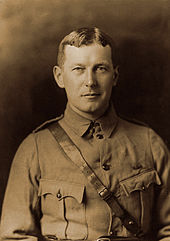
On 3 May 1915, during the Second Battle of Ypres, Lieutenant Alexis Helmer was killed. At his graveside, his friend John McCrae, M.D., of Guelph, Ontario, Canada, wrote the memorable poem In Flanders Fields as a salute to those who perished in the Great War. Published in Punch on 8 December 1915, it is still recited today, especially on Remembrance Day and Memorial Day.
Liberty Memorial in Kansas City, Missouri, is a United States memorial dedicated to all Americans who served in World War I. The site for the Liberty Memorial was dedicated on 1 November 1921. On this day, the supreme Allied commanders spoke to a crowd of more than 100,000 people. It was the only time in history these leaders were together in one place. In attendance were Lieutenant General Baron Jacques of Belgium; General Armando Diaz of Italy; Marshal Ferdinand Foch of France; General Pershing of the United States; and Admiral D. R. Beatty of Great Britain. After three years of construction, the Liberty Memorial was completed and President Calvin Coolidge delivered the dedication speech to a crowd of 150,000 people in 1926.
Liberty Memorial is also home to The National World War I Museum, the only museum in the United States dedicated solely to World War I.
Cultural memory
World War I had a lasting impact on social memory. It was seen by many in Britain as signalling the end of an era of stability stretching back to the Victorian period, and across Europe many regarded it as a watershed. Historian Samuel Hynes explained:
A generation of innocent young men, their heads full of high abstractions like Honour, Glory and England, went off to war to make the world safe for democracy. They were slaughtered in stupid battles planned by stupid generals. Those who survived were shocked, disillusioned and embittered by their war experiences, and saw that their real enemies were not the Germans, but the old men at home who had lied to them. They rejected the values of the society that had sent them to war, and in doing so separated their own generation from the past and from their cultural inheritance.
This has become the most common perception of World War I, perpetuated by the art, cinema, poems, and stories published subsequently. Films such as All Quiet on the Western Front, Paths of Glory and King & Country have perpetuated the idea, while war-time films including Camrades, Flanders Poppies, and Shoulder Arms indicate that the most contemporary views of the war were overall far more positive. Likewise, the art of Paul Nash, John Nash, Christopher Nevison, and Henry Tonks in Britain painted a negative view of the conflict in keeping with the growing perception, while popular war-time artists such as Muirhead Bone painted more serene and pleasant interpretations subsequently rejected as inaccurate. Several historians like John terriane, Niall Ferguson and Gary Sheffield have challenged these interpretations as partial and polemical views:
These beliefs did not become widely shared because they offered the only accurate interpretation of wartime events. In every respect, the war was much more complicated than they suggest. In recent years, historians have argued persuasively against almost every popular cliché of World War I. It has been pointed out that, although the losses were devastating, their greatest impact was socially and geographically limited. The many emotions other than horror experienced by soldiers in and out of the front line, including comradeship, boredom, and even enjoyment, have been recognised. The war is not now seen as a 'fight about nothing', but as a war of ideals, a struggle between aggressive militarism and more or less liberal democracy. It has been acknowledged that British generals were often capable men facing difficult challenges, and that it was under their command that the British army played a major part in the defeat of the Germans in 1918: a great forgotten victory.
Though these historians have discounted as "myths" these perceptions of the war, they are common. They have dynamically changed according to contemporary influences, reflecting in the 1950s perceptions of the war as 'aimless' following the contrasting Second World War and emphasising conflict within the ranks during times of class conflict in the 1960s. The majority of additions to the contrary are often rejected.
Social trauma
The social trauma caused by unprecedented rates of casualties manifested itself in different ways, which have been the subject of subsequent historical debate. Some people were revolted by nationalism and its results, and began to work towards a more internationalist world, supporting organisations such as the League of Nations. Pacifism became increasingly popular. Others had the opposite reaction, feeling that only strength and military might could be relied upon in a chaotic and inhumane world. Anti-modernist views were an outgrowth of the many changes taking place in society.
The experiences of the war led to a collective trauma shared by many from all participating countries. The optimism of la belle époque was destroyed, and those who had fought in the war were referred to as the Lost Generation. For years afterwards, people mourned the dead, the missing, and the many disabled. Many soldiers returned with severe trauma, suffering from shell shock (also called neurasthenia, a condition related to posttraumatic stress disorder). Many more returned home with few after-effects; however, their silence about the war contributed to the conflict's growing mythological status. In the United Kingdom, mass mobilisation, large casualty rates, and the collapse of the Edwardian era made a strong impression on society. Though many participants did not share in the experiences of combat or spend any significant time at the front, or had positive memories of their service, the images of suffering and trauma became the widely shared perception. Such historians as Dan Todman, Paul Fussell, and Samuel Heyns have all published works since the 1990s arguing that these common perceptions of the war are factually incorrect.
Discontent in Germany
The rise of Nazism and fascism included a revival of the nationalist spirit and a rejection of many post-war changes. Similarly, the popularity of the Stab-in-the-back legend (German: Dolchstoßlegende) was a testament to the psychological state of defeated Germany and was a rejection of responsibility for the conflict. This conspiracy theory of betrayal became common, and the German populace came to see themselves as victims. The Dolchstoßlegende's popular acceptance in Germany played a significant role in the rise of Nazism. A sense of disillusionment and cynicism became pronounced, with nihilism growing. Many believed the war heralded the end of the world as they had known it because of the high fatalities among a generation of men, the dissolution of governments and empires, and the collapse of capitalism and imperialism.
Communist and socialist movements around the world drew strength from this theory and enjoyed a new level of popularity. These feelings were most pronounced in areas directly or harshly affected by the war. Out of German discontent with the still controversial Treaty of Versailles, Adolf Hitler was able to gain popularity and power. World War II was in part a continuation of the power struggle never fully resolved by World War I; in fact, it was common for Germans in the 1930s and 1940s to justify acts of international aggression because of perceived injustices imposed by the victors of World War I. American historian William Rubinstein wrote that:
"The 'Age of Totalitarianism' included nearly all of the infamous examples of genocide in modern history, headed by the Jewish Holocaust, but also comprising the mass murders and purges of the Communist world, other mass killings carried out by Nazi Germany and its allies, and also the Armenian genocide of 1915. All these slaughters, it is argued here, had a common origin, the collapse of the elite structure and normal modes of government of much of central, eastern and southern Europe as a result of World War I, without which surely neither Communism nor Fascism would have existed except in the minds of unknown agitators and crackpots".
The establishment of the modern state of Israel and the roots of the continuing Israeli-Palestinian Conflict are partially found in the unstable power dynamics of the Middle East that resulted from World War I. Prior to the end of the war, the Ottoman Empire had maintained a modest level of peace and stability throughout the Middle East. With the fall of the Ottoman government, power vacuums developed and conflicting claims to land and nationhood began to emerge. The political boundaries drawn by the victors of World War I were quickly imposed, sometimes after only cursory consultation with the local population. In many cases, these continue to be problematic in the 21st-century struggles for national identity. While the dissolution of the Ottoman Empire at the end of World War I was pivotal in contributing to the modern political situation of the Middle East, including the Arab-Israeli conflict, the end of Ottoman rule also spawned lesser known disputes over water and other natural resources.
Views in the United States
U.S. intervention in the war, as well as the Wilson administration itself, became deeply unpopular. This was reflected in the U.S. Senate's rejection of the Versailles Treaty and membership in the League of Nations. In the interwar era, a consensus arose that U.S. intervention had been a mistake, and the Congress passed laws in an attempt to preserve U.S. neutrality in any future conflict. Polls taken in 1937 and the opening months of World War II established that nearly 60% regarded intervention in WWI as a mistake, with only 28% opposing that view. But, in the period between the fall of France and the attack on Pearl Harbour, public opinion changed dramatically and, for the first time, a narrow plurality rejected the idea that the war had been a mistake.
New national identities
Poland reemerged as an independent country, after more than a century. As a "minor Entente nation" and the country with the most casualties per capita, the Kingdom of Serbia and its dynasty became the backbone of the new multinational state, the Kingdom of Serbs, Croats and Slovenes (later renamed Yugoslavia). Czechoslovakia, combining the Kingdom of Bohemia with parts of the Kingdom of Hungary, became a new nation. Russia became the Soviet Union and lost Finland, Estonia, Lithuania, and Latvia, which became independent countries. The Ottoman Empire was soon replaced by Turkey and several other countries in the Middle East.
In the British Empire, the war unleashed new forms of nationalism. In Australia and New Zealand the Battle of Gallipoli became known as those nations' "Baptism of Fire". It was the first major war in which the newly established countries fought, and it was one of the first times that Australian troops fought as Australians, not just subjects of the British Crown. Anzac Day, commemorating the Australian and New Zealand Army Corps, celebrates this defining moment.
After the Battle of Vimy Ridge, where the Canadian divisions fought together for the first time as a single corps, Canadians began to refer to theirs as a nation "forged from fire". Having succeeded on the same battleground where the "mother countries" had previously faltered, they were for the first time respected internationally for their own accomplishments. Canada entered the war as a Dominion of the British Empire and remained so, although it emerged with a greater measure of independence. When Britain declared war in 1914, the dominions were automatically at war; at the conclusion, Canada, Australia, New Zealand, and South Africa were individual signatories of the Treaty of Versailles.
Economic effects
One of the most dramatic effects of the war was the expansion of governmental powers and responsibilities in Britain, France, the United States, and the Dominions of the British Empire. In order to harness all the power of their societies, governments created new ministries and powers. New taxes were levied and laws enacted, all designed to bolster the war effort; many have lasted to this day. Similarly, the war strained the abilities of some formerly large and bureaucratised governments, such as in Austria–Hungary and Germany; however, any analysis of the long-term effects were clouded by the defeat of these governments.
Gross domestic product (GDP) increased for three Allies (Britain, Italy, and U.S.), but decreased in France and Russia, in neutral Netherlands, and in the three main Central Powers. The shrinkage in GDP in Austria, Russia, France, and the Ottoman Empire reached 30 to 40%. In Austria, for example, most pigs were slaughtered, so at war's end there was no meat.
In all nations, the government's share of GDP increased, surpassing fifty percent in both Germany and France and nearly reaching that level in Britain. To pay for purchases in the United States, Britain cashed in its extensive investments in American railroads and then began borrowing heavily on Wall Street. President Wilson was on the verge of cutting off the loans in late 1916, but allowed a great increase in U.S. government lending to the Allies. After 1919, the U.S. demanded repayment of these loans. The repayments were, in part, funded by German reparations, which, in turn, were supported by American loans to Germany. This circular system collapsed in 1931 and the loans were never repaid. In 1934, Britain owed the US $4.4 billion of World War I debt.
Macro- and micro-economic consequences devolved from the war. Families were altered by the departure of many men. With the death or absence of the primary wage earner, women were forced into the workforce in unprecedented numbers. At the same time, industry needed to replace the lost labourers sent to war. This aided the struggle for voting rights for women.
World War I further compounded the gender imbalance, adding to the phenomenon of surplus women. The deaths of nearly one million men during the war increased the gender gap by almost a million; from 670,000 to 1,700,000. The number of unmarried women seeking economic means grew dramatically. In addition, demobilisation and economic decline following the war caused high unemployment. The war increased female employment; however, the return of demoblised men displaced many from the workforce, as did the closure of many of the wartime factories. Hence women who had worked during the war found themselves struggling to find jobs and those approaching working age were not offered the opportunity.
In Britain, rationing was finally imposed in early 1918, limited to meat, sugar, and fats (butter and oleo), but not bread. The new system worked smoothly. From 1914 to 1918, trade union membership doubled, from a little over four million to a little over eight million. Work stoppages and strikes became frequent in 1917–1918 as the unions expressed grievances regarding prices, alcohol control, pay disputes, fatigue from overtime and working on Sundays, and inadequate housing.
Britain turned to her colonies for help in obtaining essential war materials whose supply had become difficult from traditional sources. Geologists such as Albert Ernest Kitson were called on to find new resources of precious minerals in the African colonies. Kitson discovered important new deposits of manganese, used in munitions production, in the Gold Coast.
Article 231 of the Treaty of Versailles (the so-called "war guilt" clause) declared Germany and its allies responsible for all "loss and damage" suffered by the Allies during the war and provided the basis for reparations. The total reparations demanded was 132 billion gold marks, which was far more than the total German gold or foreign exchange. The economic problems that the payments brought, and German resentment at their imposition, are usually cited as one of the more significant factors that led to the end of the Weimar Republic and the beginning of the dictatorship of Adolf Hitler. After Germany's defeat in World War II, payment of the reparations was not resumed. There was, however, outstanding German debt that the Weimar Republic had used to pay the reparations. Germany finished paying off the reparations in October 2010.
